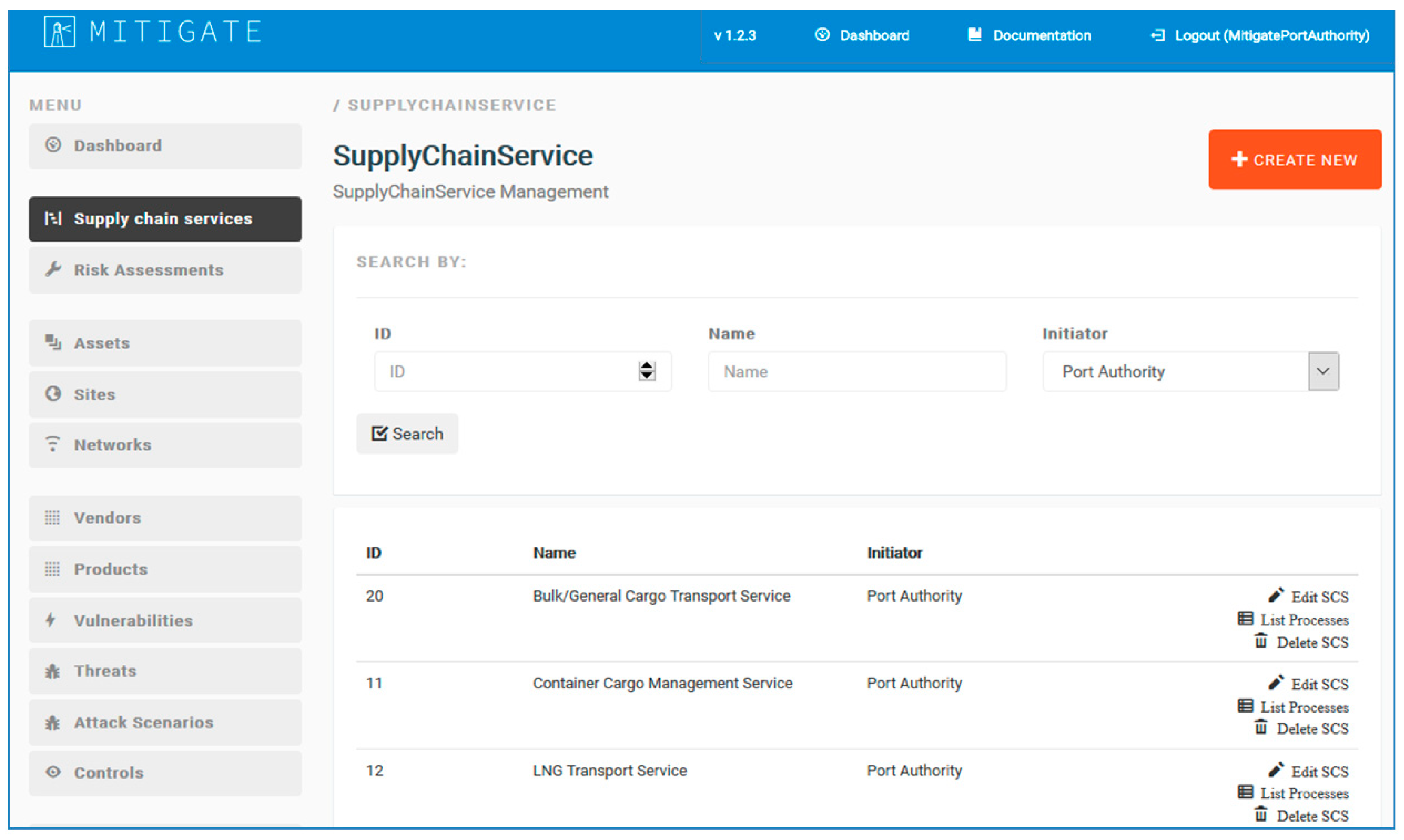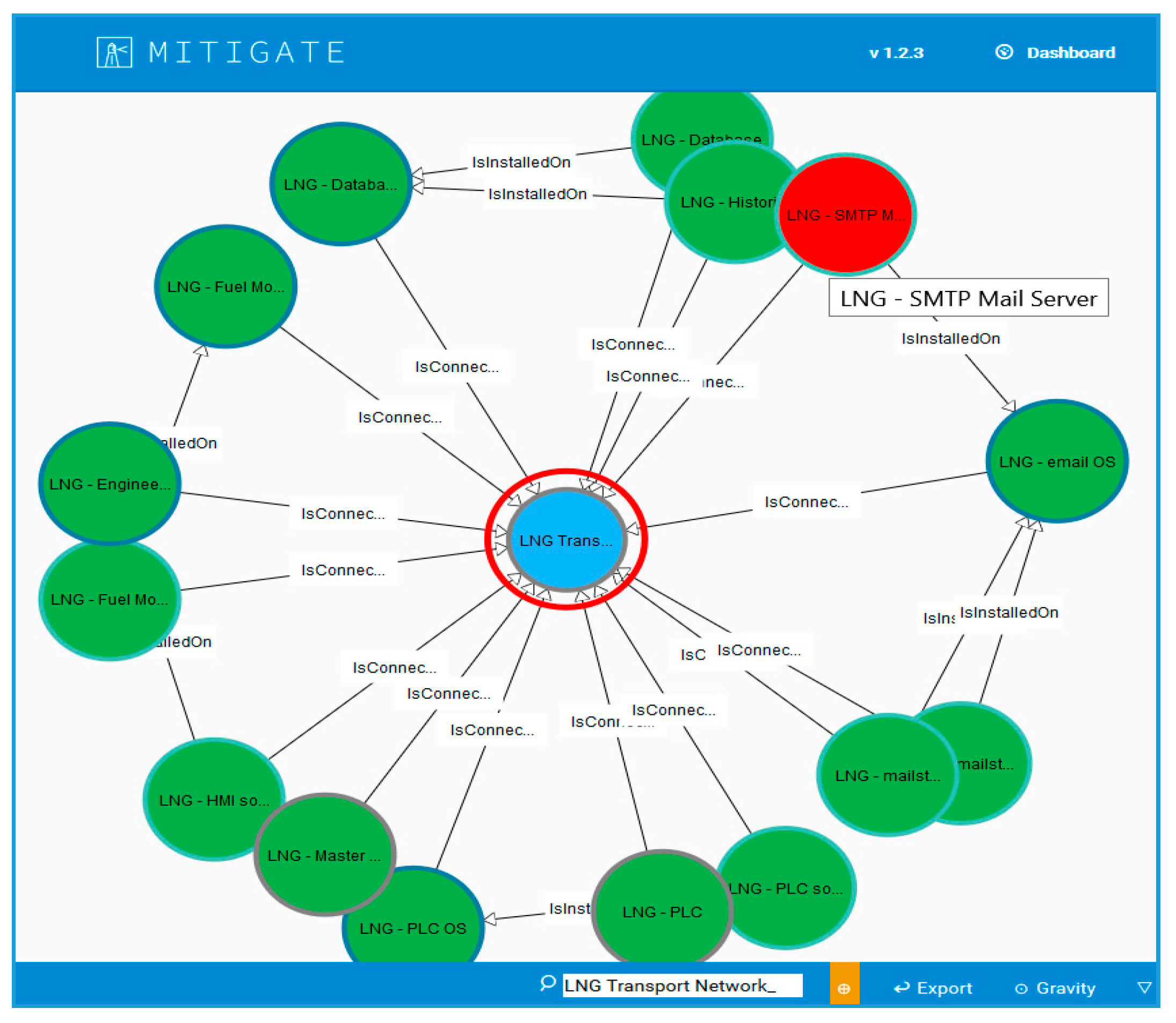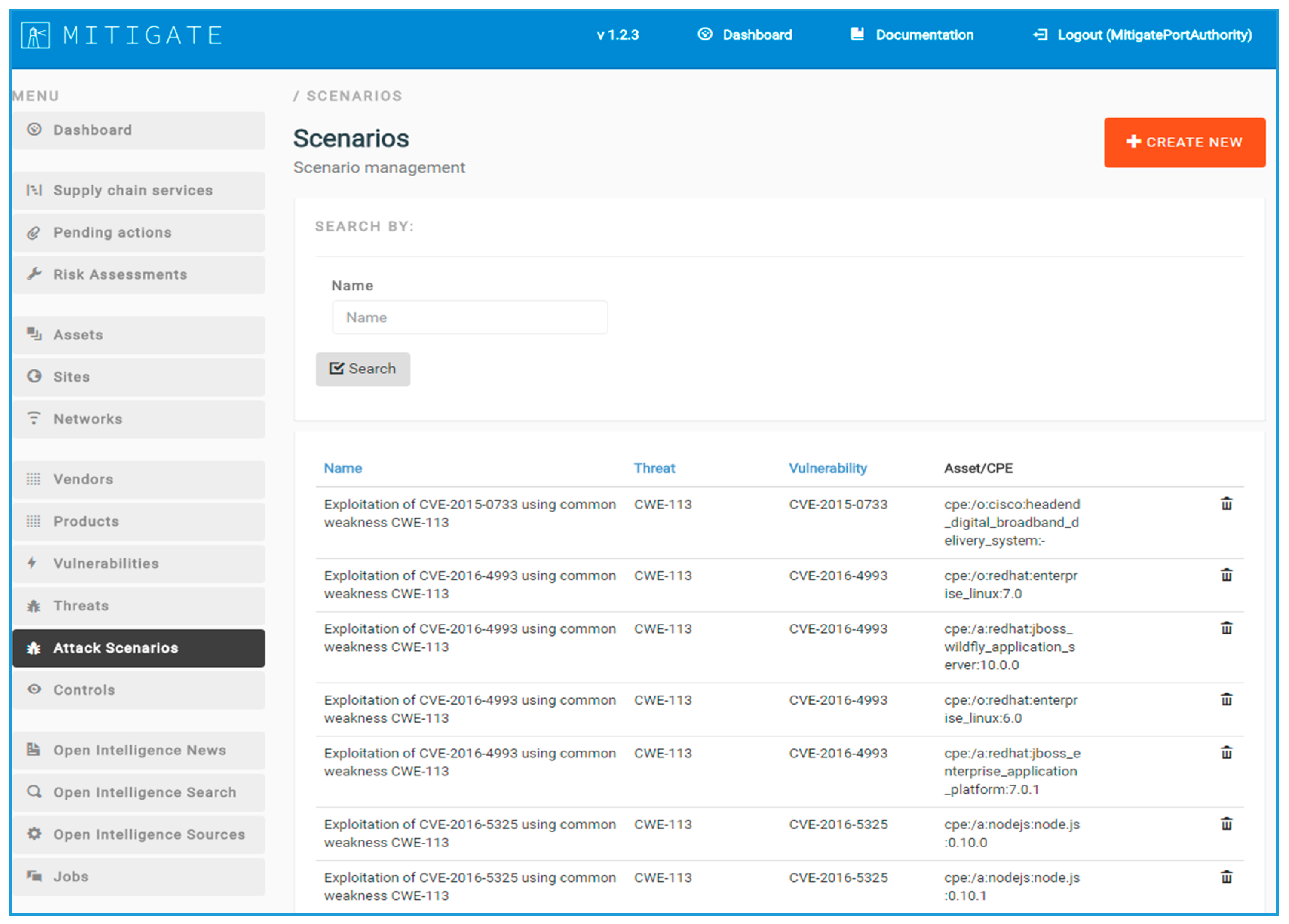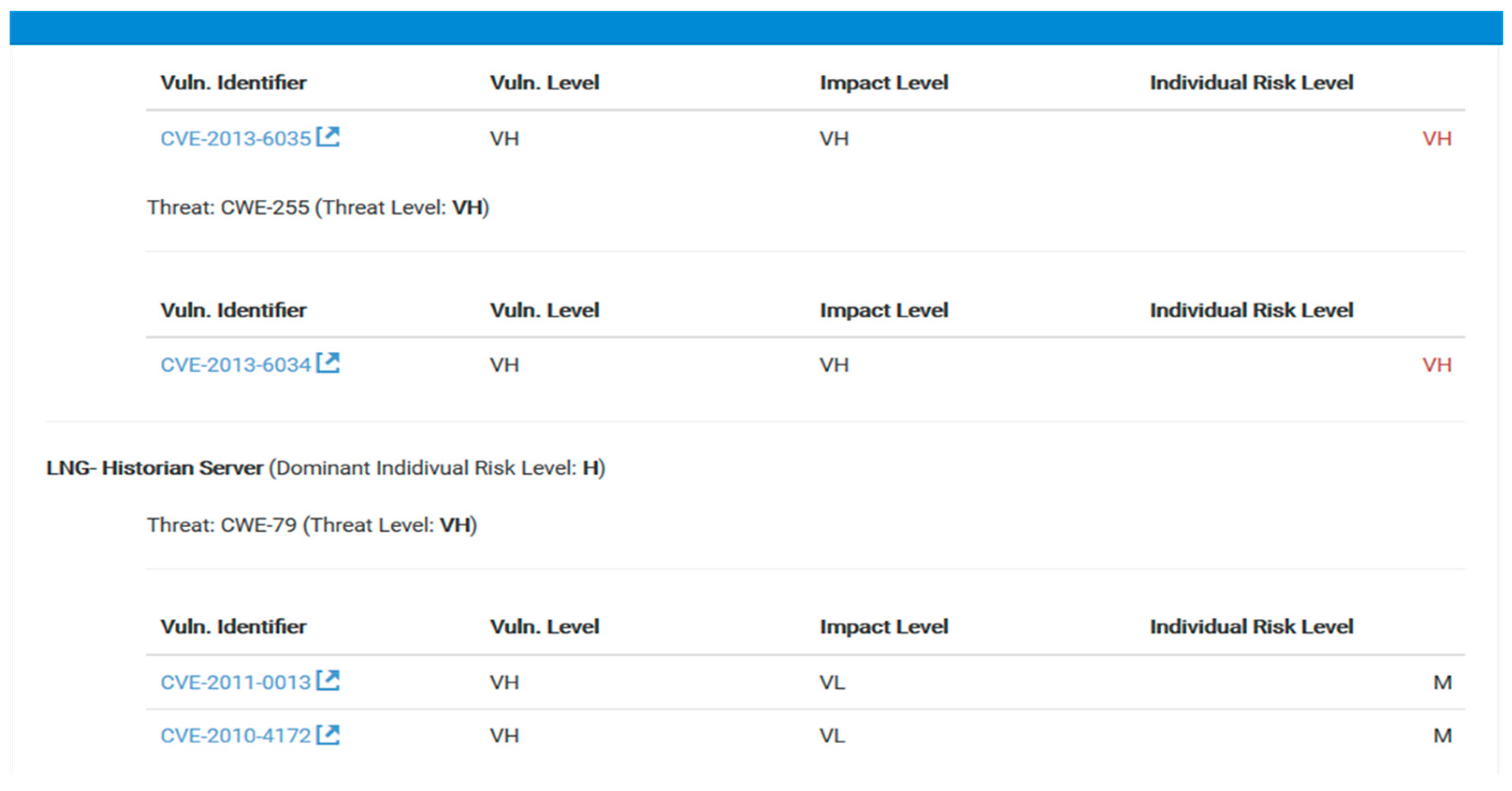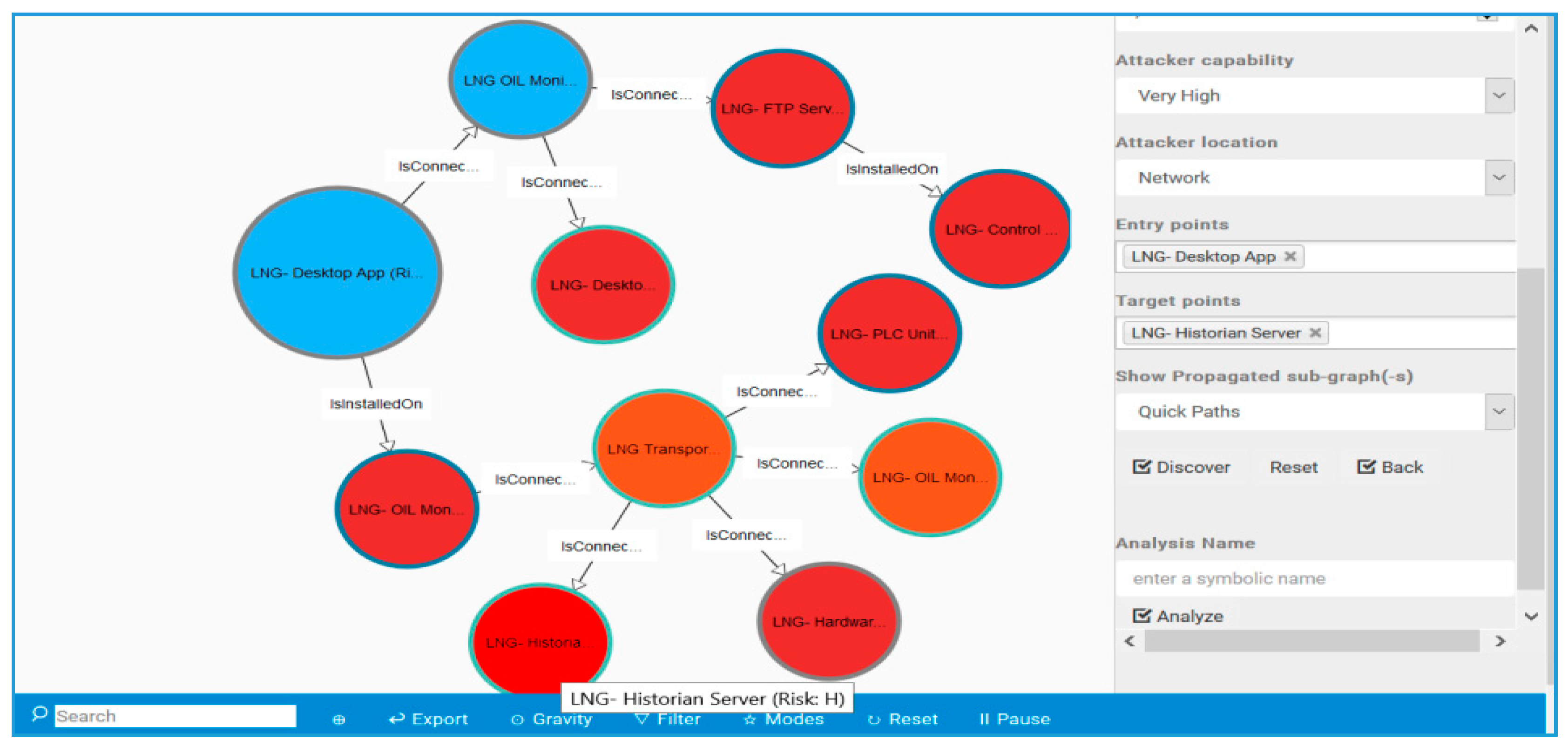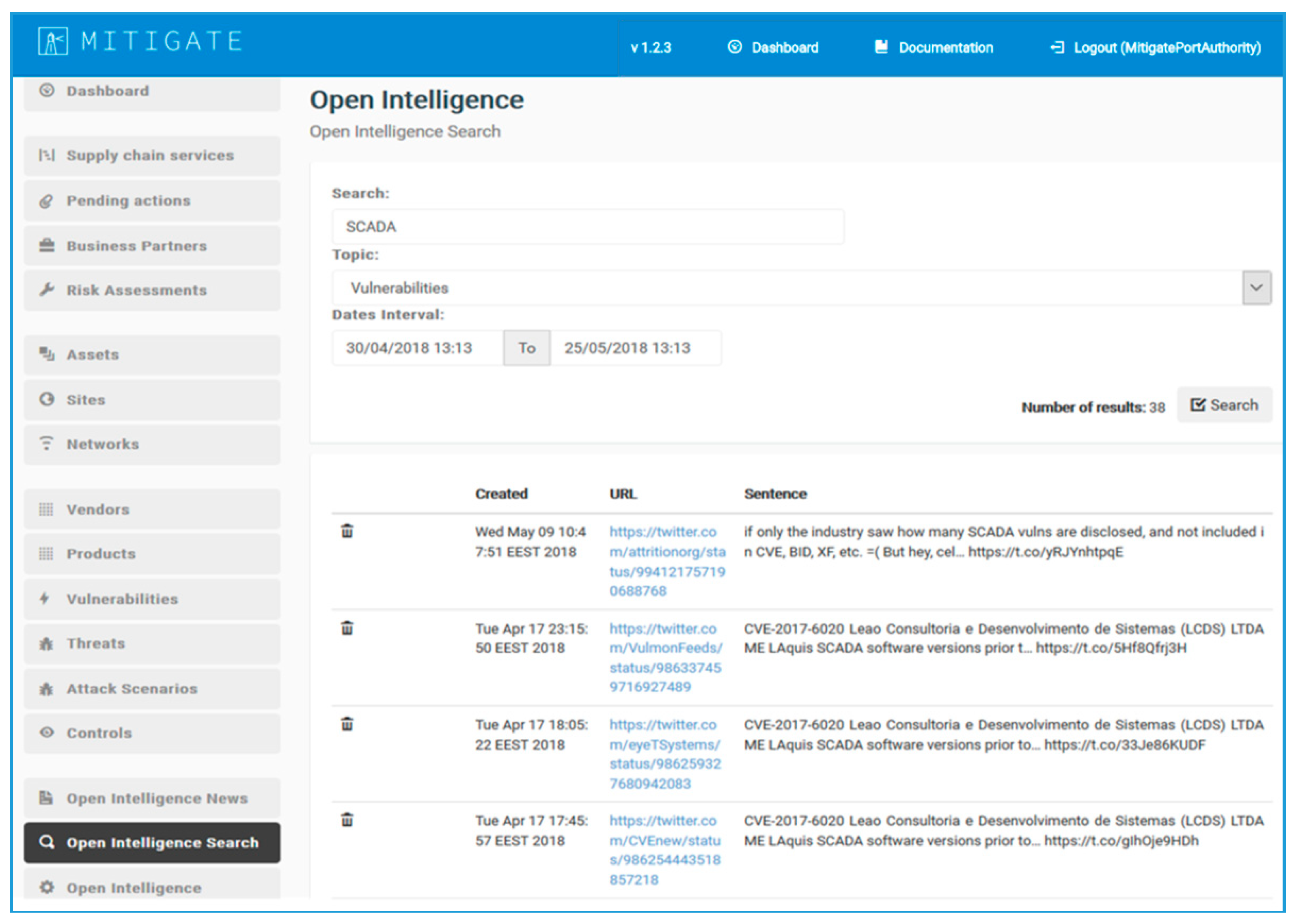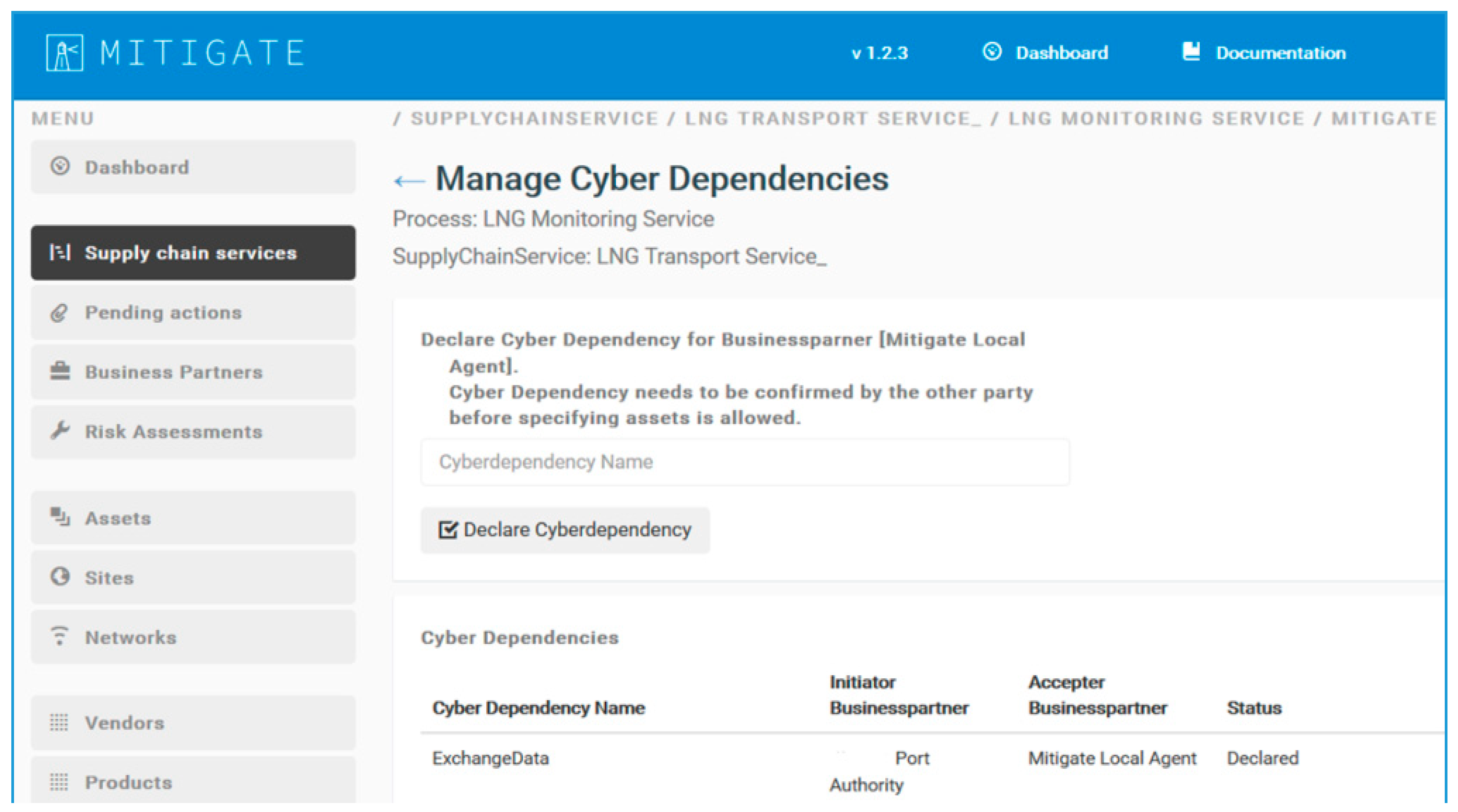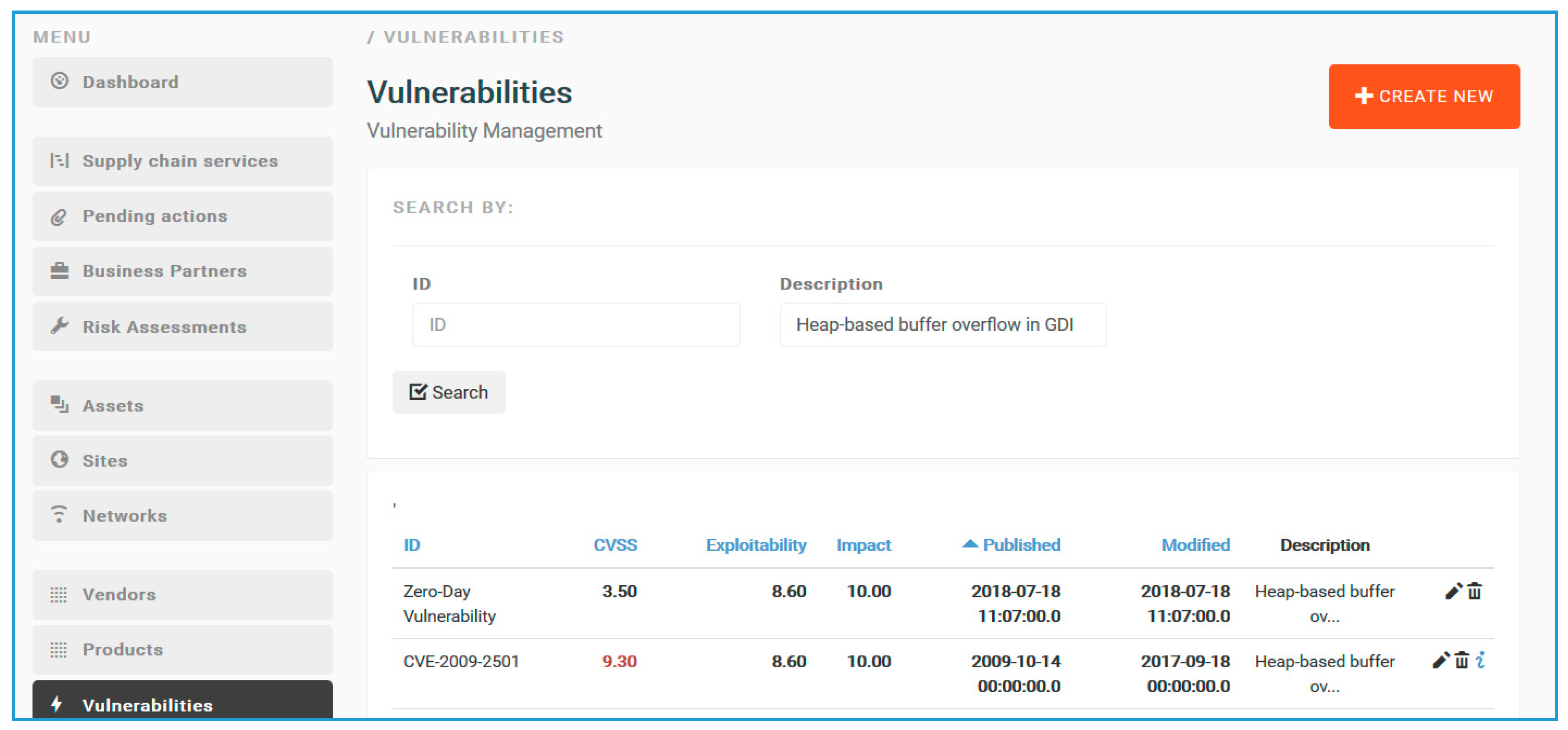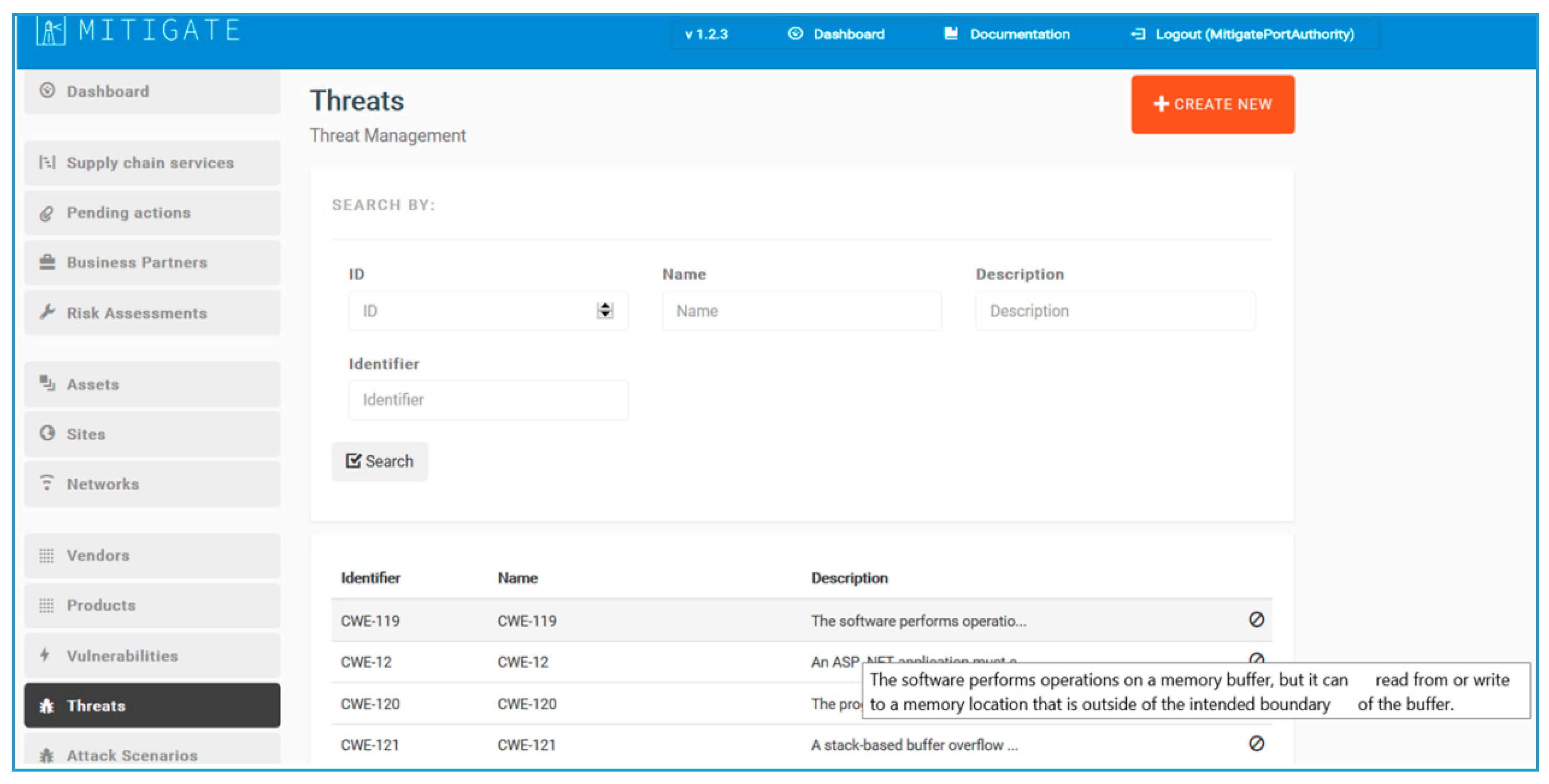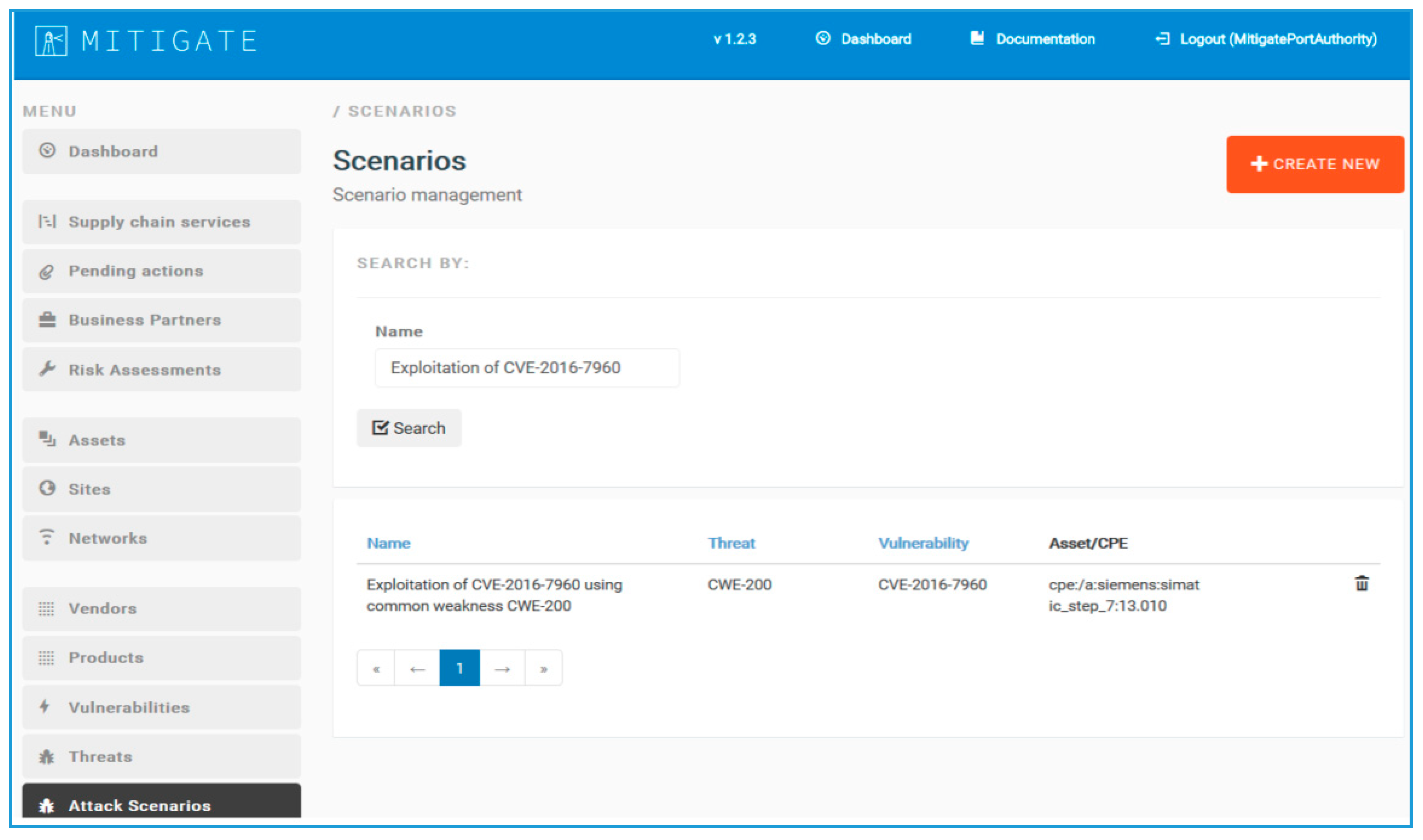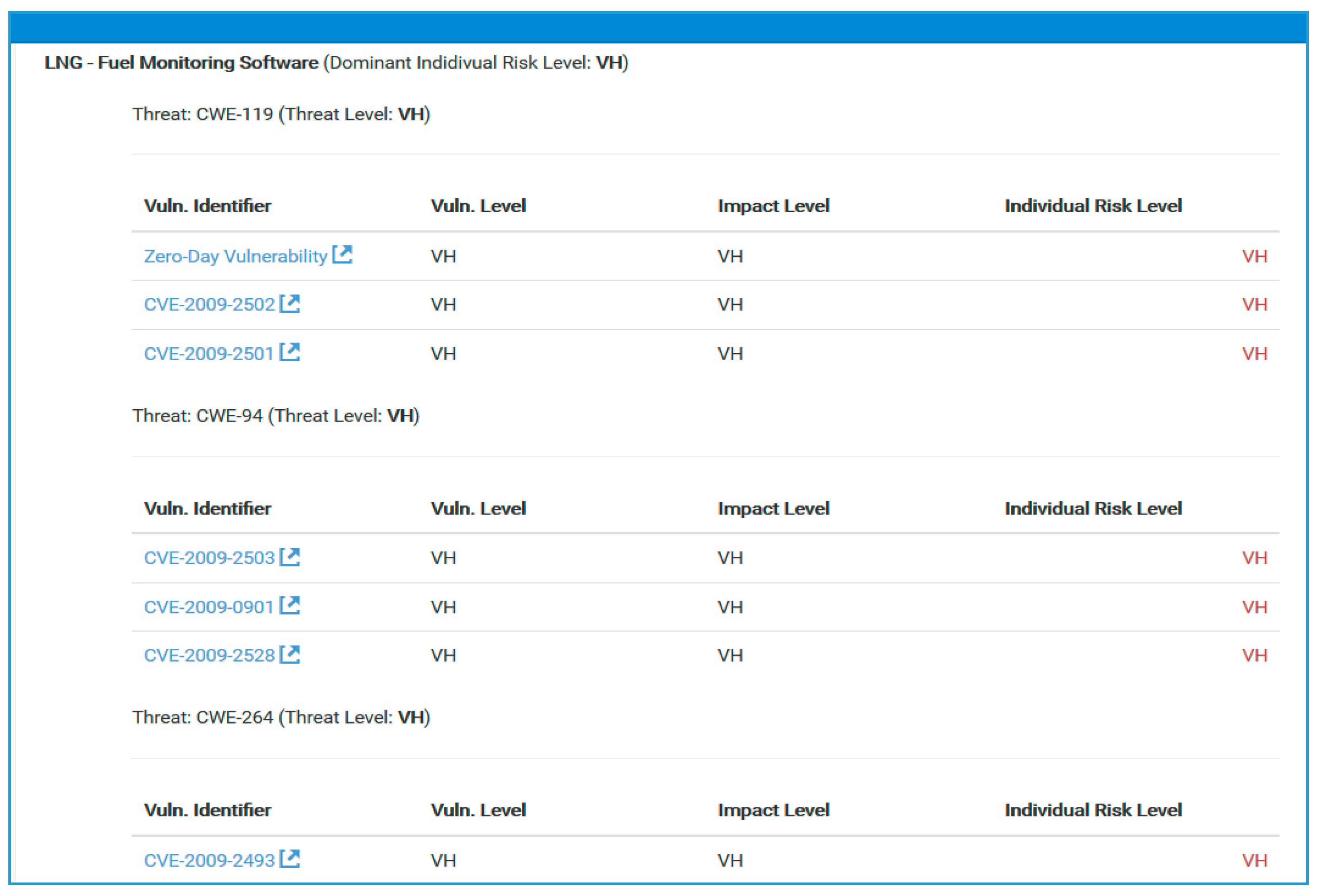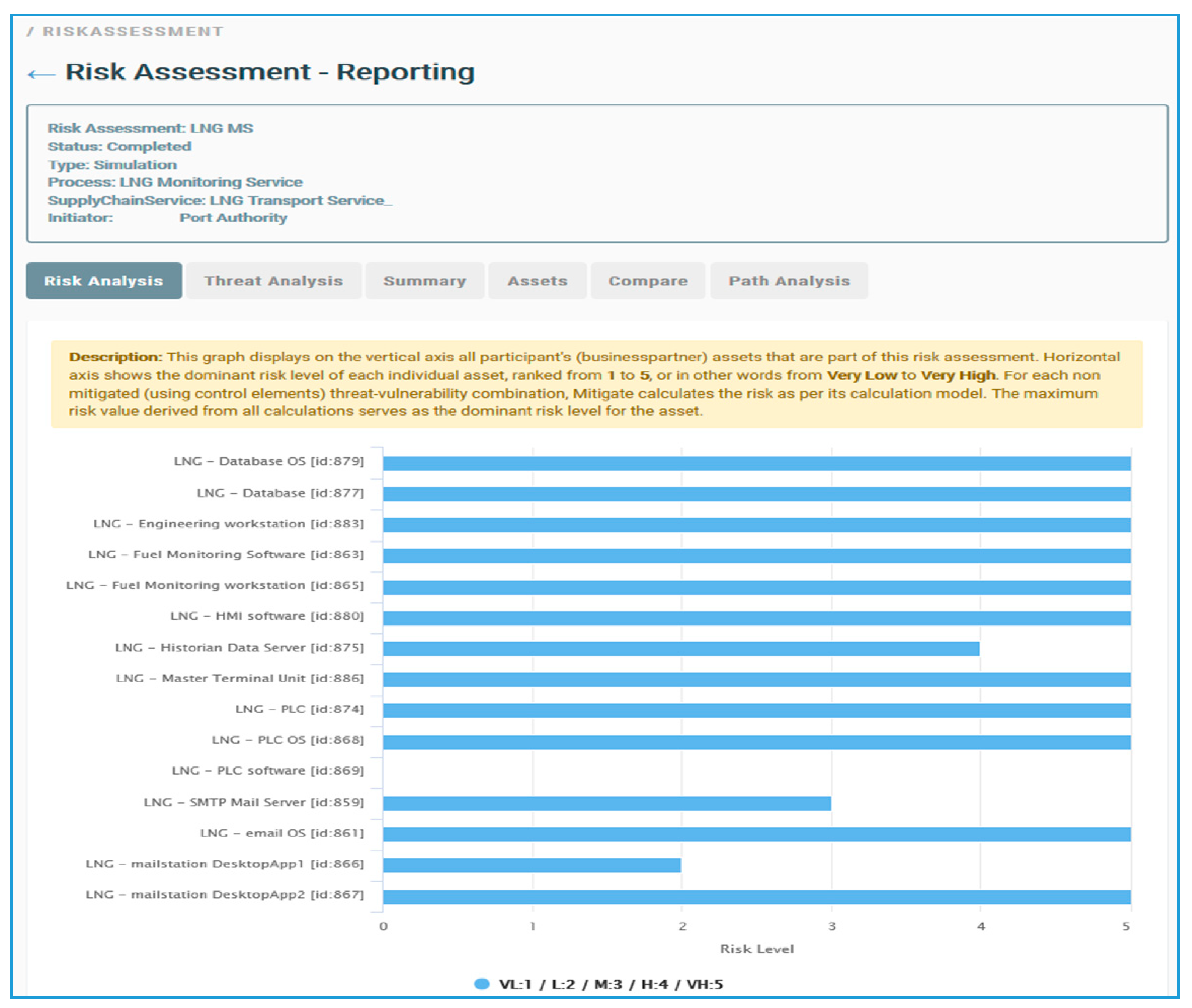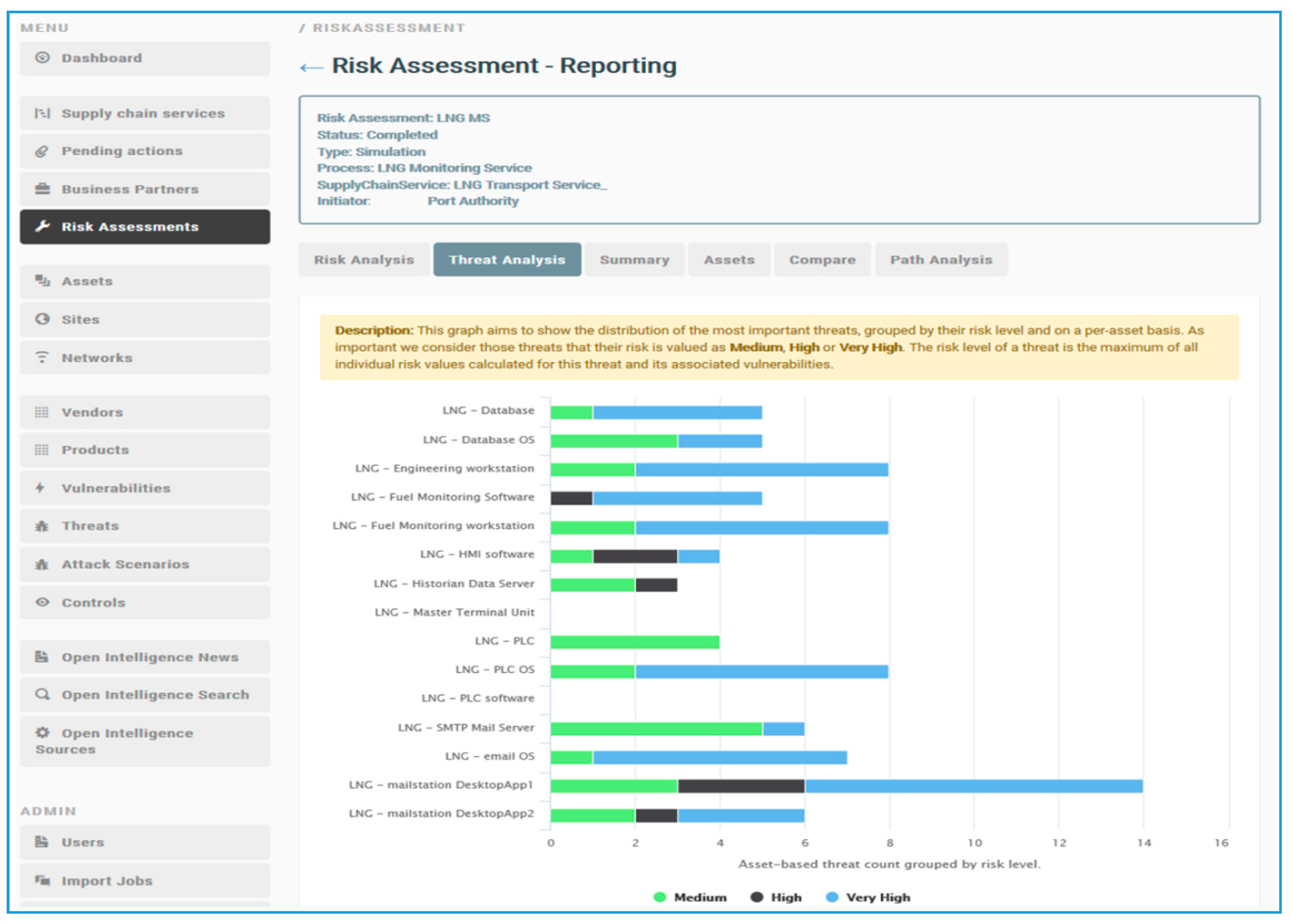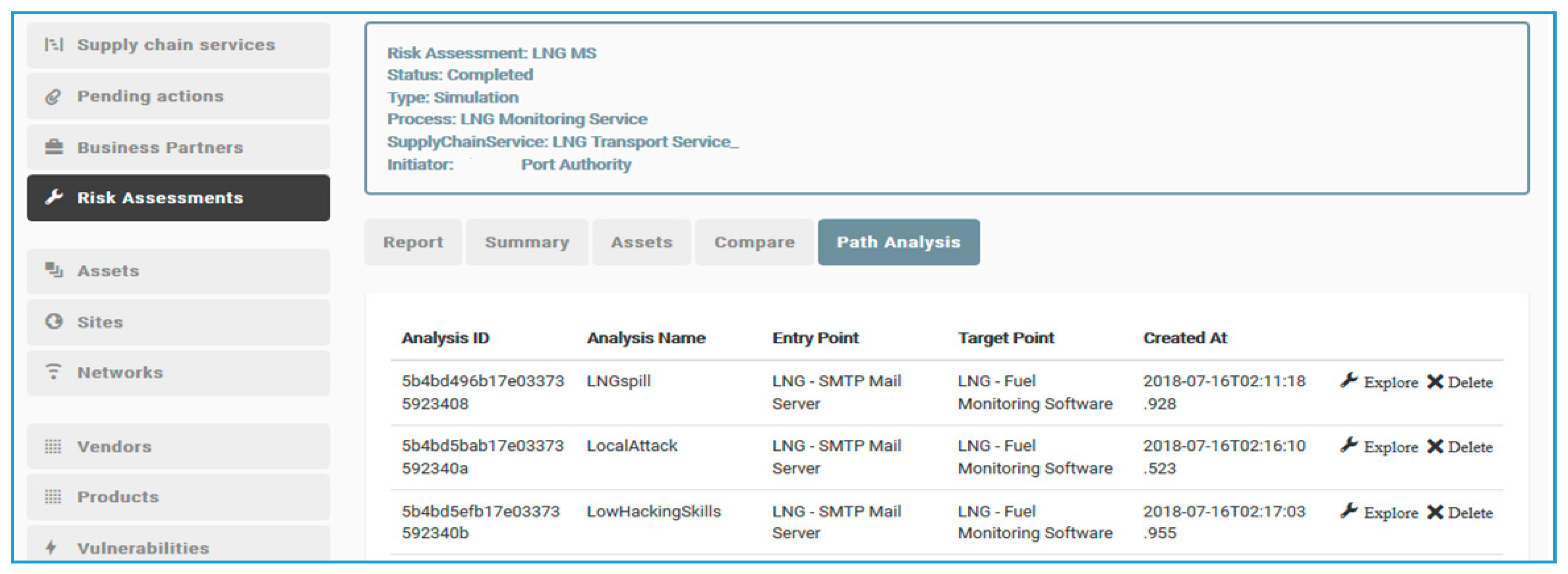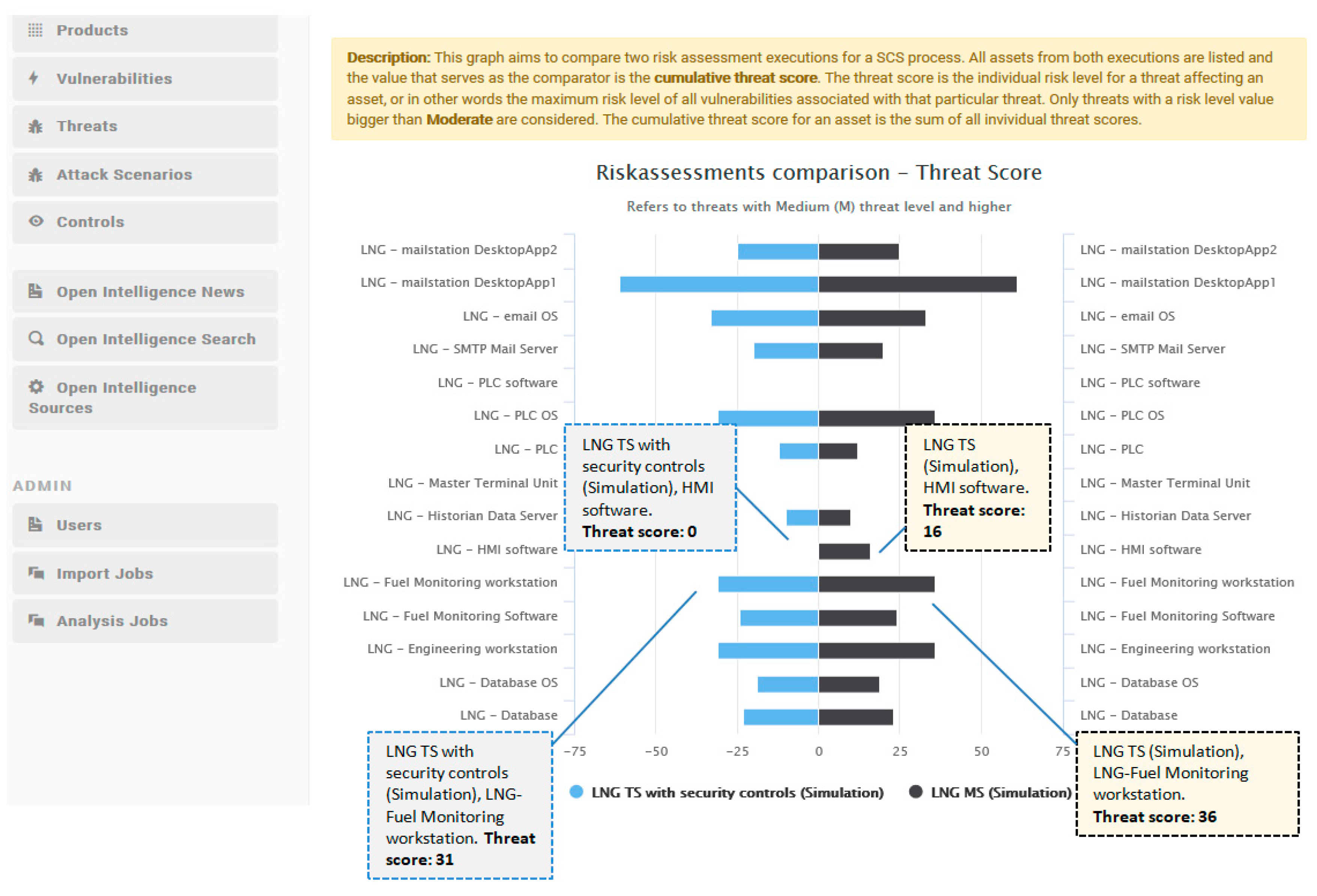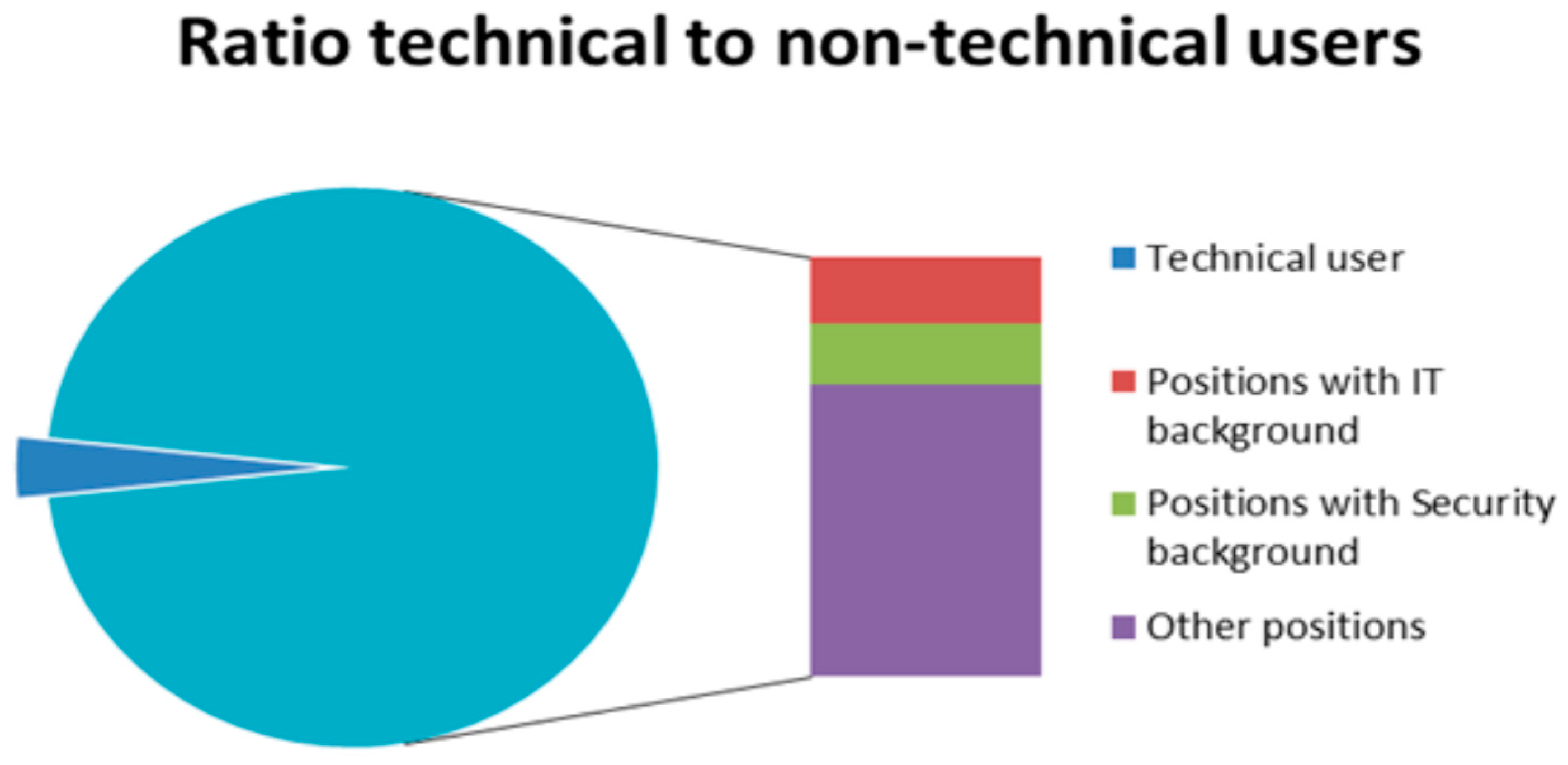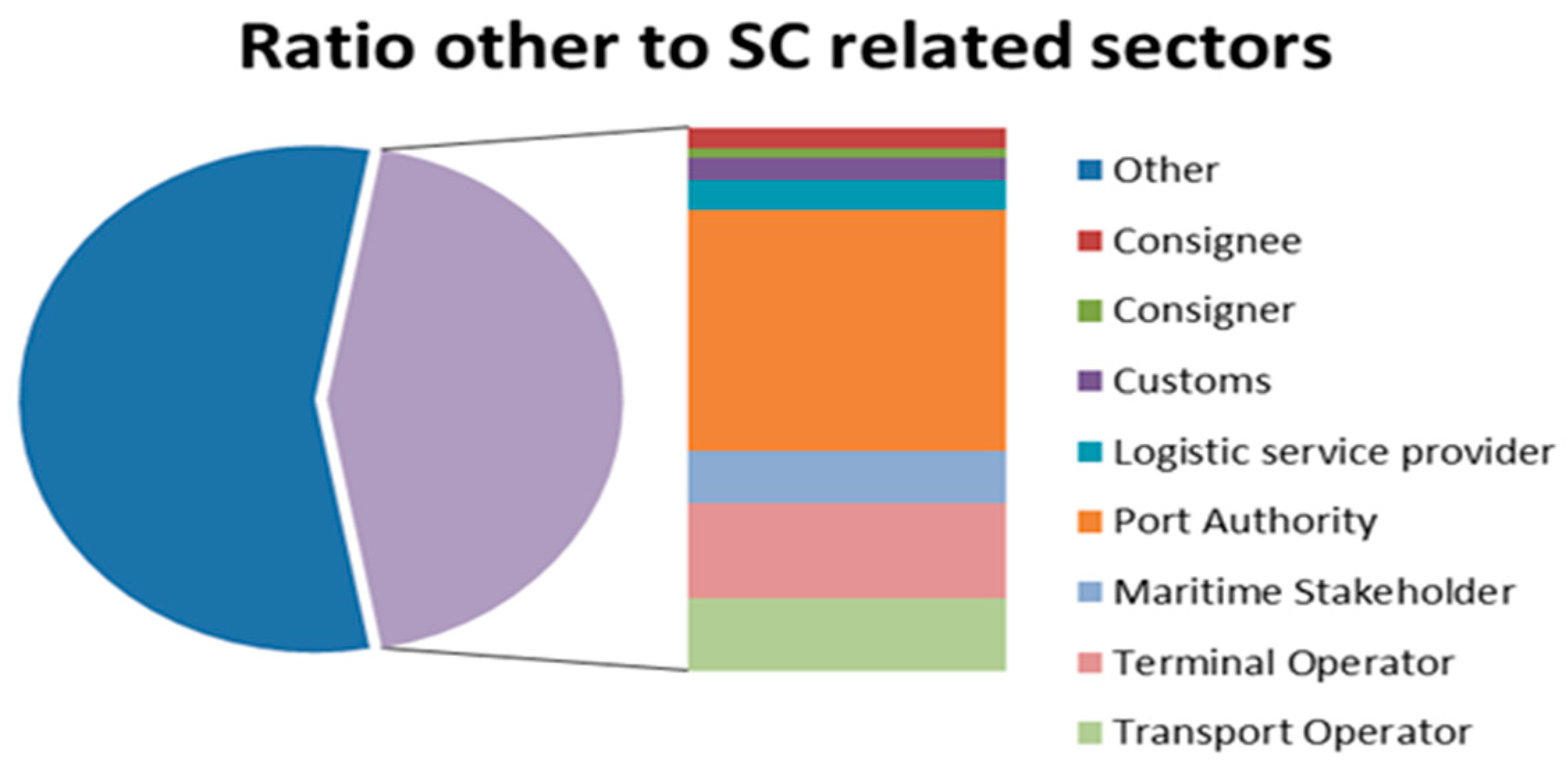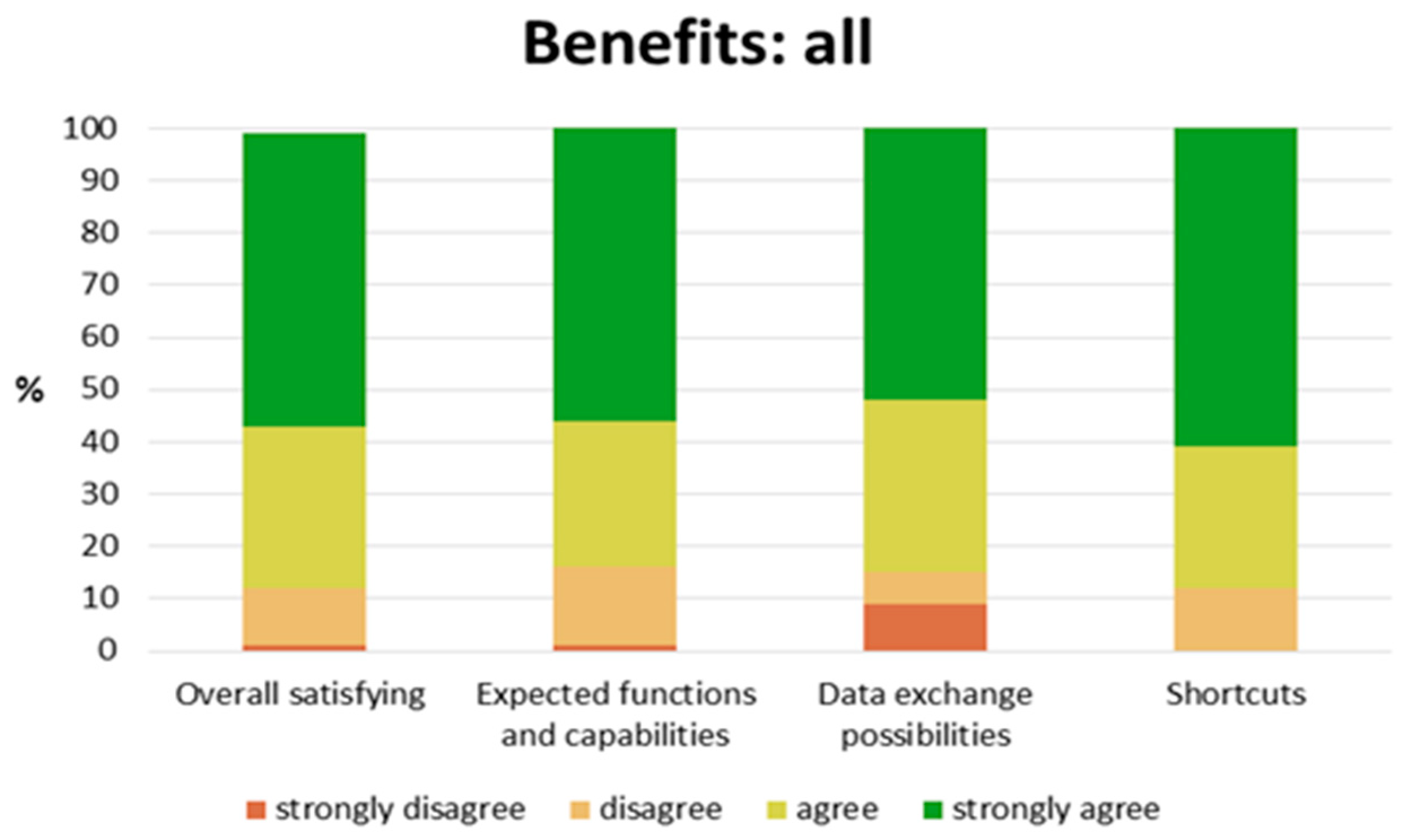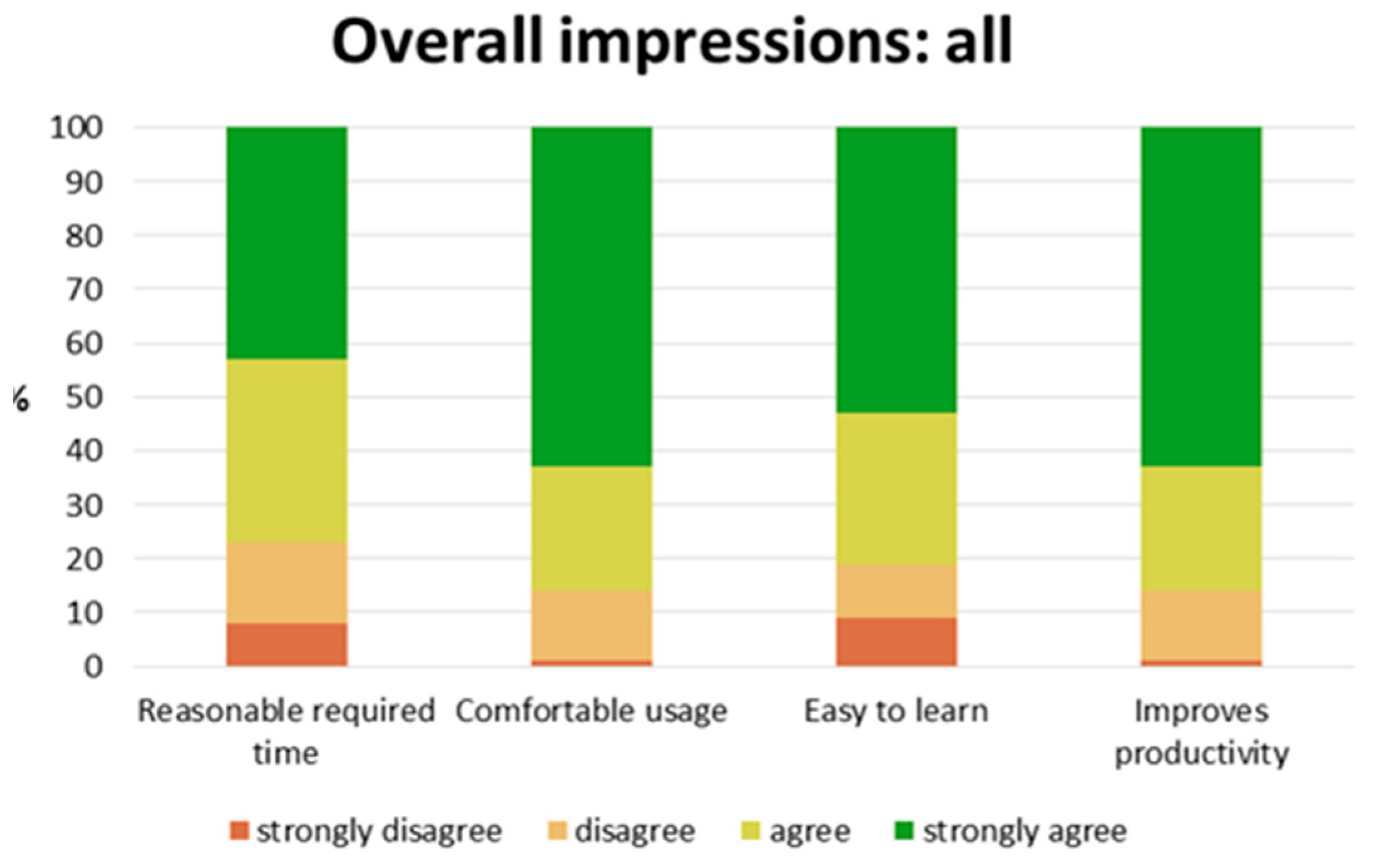1. Introduction
In the modern era, Maritime Logistics and Supply Chains (MLoSCs) are the blood veins of global trade and economy where cross-border Critical Infrastructures (CI), such as ports, maritime authorities, airports, railways, energy providers, banks, maritime logistics and transport companies, collaborate in offering critical complex services, such as container management, vehicle transport, Liquefied Natural Gas (LNG) transport and cruising. The CIs that operate within their MLoSCs have physical and cyber multi-interdependencies, interacting with all sectors of the economy and therefore, their malfunctioning or disruption could have cascading effects on several other infrastructures or services depending on it throughout the global supply chain.
MLoSC services embed physical processes, such as vehicles and cargo stevedoring, ports Plant power supply procedures, pipeline management during LNG transport, which are monitored and controlled by composite and heterogeneous Industrial Control Systems (ICS) including Supervisory Control and Data Acquisition (SCADA) systems, Distributed Control Systems (DCS) and Programmable Logic Controllers (PLCs). Such installations play a vital role in the Maritime Industry as they analyze and display information aiming to promote a smooth and efficient performance of maritime logistics operations. SCADA systems, because of their high-level automation mechanisms and data interpretation capabilities, have managed to reduce waste of time and provide cost savings in logistics, maritime transport and control operations. In addition, they can gather environmental information, such as temperature, to protect both Port’s plant and cargoes from physical disasters and potential industrial hazards [
1].
Cargo ships are connected to ports and other MLoSCs operators via a plethora of communication and data links (e.g., through satellite network or conventional radio channel) and their navigation today is widely reliant on electronic solutions (e.g., satellite navigation with GPS, Galileo, Radar ARPA-Radio Direction and Ranging).
MLoSCs can be viewed as complex CPSs composed of heterogeneous, interconnected physical and cyber assets, owned by different national and foreign CIs, ensuring seamless and swift product/data exchange from the producer down to the end consumer.
MLoSCs’ interconnected physical and cyber assets are highly valuable and thus lately they have become targets for attacks [
2], attracting the attention of terrorism (e.g., Russian Business Network) [
3], cyber-hacktivism organizations, militias (e.g., Anonymous, LulzSec) [
3] and agencies (e.g., Stuxnet, Flame, Conficker, DuQu, APT1) [
3]. In this context, the MLoSCs have garnered front-page attention as a victim of recent cyber-attacks: (i) A Chinese manufacturer stands accused of implanting malware in inventory scanners to steal supply chain intelligence [
4]; (ii) hackers recently shut down a floating oil rig by tilting it [
5]; (iii) engineering experiments have demonstrated that low-cost GPS jammers can be used to change a vessel’s course by interfering with its navigation systems (GPS, ECDIS, AIS) causing a trackline-following autopilot to inaccurately interpret the ship’s position and alter its course [
3]; (iv) Somali pirates used hackers to gain access to shipping company’s databases and vessel tracking systems to identify vessels with valuable cargoes, thus, many ships that transit the Gulf region are turning their Automatic Identification System (AIS) navigation tracking system off so that pirates cannot identify, locate and track them [
3]; (v) in port of Antwerp, between 2011 and 2013, cyber-attacks were used to highjack, divert, or steal cargo [
3]; (vi) a major maritime company, engaged in a deal to order a sea floor mining vessel, was the victim of a cyber-attack as it unknowingly pre-paid (
$10 million of the
$18 million charterer’s guarantee) the deposit into a bank account that belonged to a cyber-criminal [
6].
Attacks on the MLoSC may cause not only disruption of its services but also tremendous damage to the maritime operations and furthermore to the economies, societies, and environment, threatening the safety, security and stability within the EU and beyond. For example, an illegal intrusion on the ICS (e.g., supervisory control, SCADA installations) hosted in ports or maritime transport companies may lead to the disruption of loading/unloading services or harm critical mechanical devices (e.g., container cranes, safety and mechanical systems that operate locks and dams), or even worse, cause human casualties, loss of cargo and serious vessel damages. Another example is an attack on a container terminal management system causing malfunctions in the intermodal container services involving maritime, rail and truck transportation. Cyber-attacks (e.g., inserting a malware) in the ports’ SCADA systems may generate fuel spills and affect water quality; attacks in the Port Community Systems (PCS) may turn LNG tankers into floating bombs; physical attacks (e.g., bombing) in a dry bulk storage area of coal products may create and carry dust by wind to tourist terminals or nearby residences.
Due to these threats, there is an urgent, pressing challenge for MLoSCs security officers and operators to protect their interconnected CIs’, such as SCADA systems (i.e., telemetry systems, pipelines monitoring system, data collectors, lift stations and gantry crane crowbars) in the new digital maritime era. Existing risk management policies in EU Ports are using their own disparate methodologies which hurdles the comparison of risk assessment results among the Member States and greatens the appearance of cross-border multi-risks across the MLoSC [
7]. In addition, the literature review [
7,
8] raises the challenge to update and combine security standards, such as NIST800-37 [
9], ISO27001 [
10], ISO27005 [
10] and ISO28001 [
11]. Furthermore, there is a compelling need for more targeted Risk Assessment (RA) approaches dealing with the distributed and interconnected nature of the dynamic, ICT-based MLoSC environments.
The current study aims to present a novel evidence-based risk assessment methodology and illustrate the utilization of its generated sophisticated RA system, which has been developed under the EU H2020 Research Project “MITIGATE” [
12]. The proposed methodology addresses the specificities and particularities of MLoSC cyber-assets, such as composite SCADA-based infrastructures and evaluates their evolving risk landscape by identifying assets interdependencies regarding the associated threats and cascading effects. To illustrate the level of disruption and damage that can cause a potential sophisticated cyber-attack to the MLoSC performance and underscore the necessity of protecting complex maritime logistics infrastructures, such as SCADA systems, we present three real-life SCADA cyber-attack scenarios on critical services of the MLoSC. Furthermore, to demonstrate how cybersecurity risks of SCADA installations pertaining the MLoSC can be captured, assessed and evaluated, we implement the MITIGATE effective, collaborative, standards-based security assessment services on a relevant SCADA supply chain scenario. To this purpose, all threats arising from the global supply chain will be considered, including those related to port CIs interdependencies and associated cascading effects.
Section 2 presents related works. In
Section 3 security challenges on Industrial Control Systems (ICS) are addressed.
Section 4 describes the MITIGATE evidence-driven risk assessment methodology and analyze its security assessment services.
Section 5 presents SCADA real-life cyber-attack scenarios on maritime logistics critical services.
Section 6 refers to the utilization of the MITIGATE system security assessment services on SCADA systems.
Section 7 states the evaluation process and findings of the MITIGATE risk assessment methodology; it presents the limitations of existing RA methods, highlights corresponding MITIGATE advantages and reports the evaluation findings. Eventually,
Section 8 integrates conclusion and discussion topics.
2. Risk Assessment Methodologies on Contemporary Maritime Logistics Infrastructures
A systemic review has been carried out to identify relevant existing literature on topics of supply chain security requirements engineering, risk management and supply chain security management standards of the Maritime Logistics Industry, to adumbrate cutting-edge issues and elicit important challenges.
Risk Assessment (RA) practices for CPSs have been developed over the past 40 years and they are still searching for methods to comprehend and facilitate the monitoring of risks [
13]. The underlying principles of RA are captured in the National Academy of Science (Red Book) [
14], where assessment and decision-making are distinguished [
15].
With respect to SCADA systems, risk is assumed “a function of the likelihood of a given threat-source exploiting a potential vulnerability and the resulting impact of a successful exploitation of the vulnerability” (7). According to ISO/IEC 13335-1:2004 definitions [
16], security goals are traditionally categorized into (i) Confidentiality (information is not made available or disclosed to unauthorized entities); (ii) Integrity (safeguarding the accuracy and completeness of assets) and (iii) Availability (being accessible and usable upon demand by an authorized entity).
RAs are generally categorized into qualitative, quantitative and hybrid methods, which are a combination of the first two. Remarkable examples of semi-quantitative RA approaches for maritime logistics assets are found in the literature, such as the Fault Tree Events Analysis which estimates the frequency of event occurrence in an undesired (top/root) logical scale [
17]. The OBEST object-based event scenario tree illustrates combined features of event tree analysis and Monte-Carlo discrete event simulation along with concepts of object-oriented analysis for RA [
18]. Schneier [
19] introduced the attack trees as a method to formalize the security of systems and subsystems regarding varying attacks. A probabilistic-based RA Tool provides a foundation for the estimation of risk reduction when applied to SCADA security [
20]. Augmented vulnerability trees and two new indices for quantifying risks were introduced by Graham, Patel, and Ralston [
17]. Cheminod et al. [
21] have presented the Quantitative modeling SCADA vulnerabilities CRA. A scenario-based approach to risk analysis in support of cybersecurity has been introduced [
22]. In 2009, a cyber-terrorism SCADA risk framework has been presented [
23].
The Institute for Information Infrastructure Protection (I3P), founded by the Department of Homeland Security (DHS) is a research SCADA project for “Unifying Stakeholders and Security Programs to Address SCADA Vulnerability and Infrastructure Interdependencies” [
24], which aims to raise the security awareness of process control systems.
The key-concepts and impact measurement in SCADA systems, including system (asset), vulnerability, threat impact (consequence) and security control-countermeasure have been identified [
8,
24,
25,
26,
27]. Cherdantseva et al. [
8] have highlighted considerable risk assessment approaches on SCADA systems ranging from 2004 to 2014, stemming from the following countries: USA, Korea, France, Canada, China, Australia, Serbia, Ireland, and Italy. Cardenas et al. [
28] cover the scope broader than RA and also describe modules for attack detection and automated response to an attack. Ten et al. [
29] is a considerable research work introducing the four components of the security framework for SCADA systems: Real-time monitoring, anomaly detection, impact analysis and mitigation strategies. Byres et al. [
30] illustrate the use of attack trees for assessing vulnerabilities in SCADA systems and control hardware. Significant research is carried out on assessing the Byres attack trees, to estimate vulnerabilities in SCADA systems based on MODBUS and MODBUS/TCP communication protocols and reckon the features of the topmost attack event investigating possible ways to achieve the final goal of the attack [
8]. The literature shows that machine learning, Artificial Intelligence (AI) and data mining technologies are thoroughly utilized in SCADA Intrusion Detection Systems (IDS) to identify threats. In general, a strong reason is their ability to treat a variety of historical data sets, which improves the IDS performance [
31]. Indicative research works on such SCADA IDS recognizing malicious traffic can be found in [
31,
32,
33].
Haimes and Horowitz [
34] describe the eight-phase process risk filtering, ranking, and management method (RFRM) which builds on an adaptive two-player Hierarchical Holographic Modeling (HHM) method to identify risks. The approach updates on the advances in probabilistic RA that can be applied to estimate the risk (exposure or expected loss) from SCADA and DCS installations.
To delineate risk assessment processes, there are various attempts to structure ontologies for general risk assessments, such as the AURUM system [
35]. The OCTAVE method [
36] is a priori distribution referring to subjectively estimated probabilities according to the Bayesian approach using UML modeling language. The CORAS [
37] method allows the integration of several different risk assessment processes the recognition of the probability of an attack is done a priori to any risk assessment and not automatically. The MEDUSA’s research method [
38] sets a number of concepts, algorithms, and tools evolved from research, specially designed to protect the IT infrastructure and associated systems.
Standards and norms range from general considerations and guidelines for risk management processes, such as ISO 31000:2009 [
39], ISO 31010 [
39], ONR 49000:2004 [
40], to specific guidelines for the IT sector; ISO 20000 [
41], ISO 27000 [
10], ISO/IEC 27005:2013 [
10], ISO 27001:2005 [
10], ISO/IEC 27005:2011 [
10], NIST2002 [
42], NIST800-37 [
9], NIST800-30 [
43], BSI: IT-Grundschutz catalogues [
44] and to highly specific frameworks, such as EC725/2004 [
45], CISSP/ICS 2015 [
46], IMO04 [
47], ISO 20858 [
48] of the maritime sector. Most of these standards specify framework conditions for the risk management process but rarely go into detail on specific methods to analyze and assess cyber-risks, making it difficult to delineate a direct comparison of results among several and varied risk assessment applications. However, the CISSP/ICS 2015 certification provides some directions for risk calculation. The EU Directive (2015/C261/03) [
49], “Risk Management Capability Assessment Guidelines” sets RA impact clarifications for CIs of the Energy and Transport sectors, which impedes the assessment of all vital services provided by CIs.
Summarizing, the literature shows that effective cost-benefit analysis and evaluation of SCADA cyber-risks are based on a straightforward approach combining a set of parameters and features, such as the likelihood of security events, the consequences of the event itself and the exploitation level of vulnerability [
50]. The current work will present how the Mitigate security assurance services implementation justifies this approach using rational decision-making techniques.
3. Security Challenges in Industrial Control Systems
ICSs in the Maritime Logistics Industry encompass SCADA, DCSs, and PLCs. They are found in the dockside container cranes, straddle-carriers and autonomous vehicles supporting stevedoring procedures and transporting containers in a commercial port with GPS and optical recognition port operations [
51]. In addition, they are used in the bulk liquid and dry cargo handling systems that load and unload grain, crude oil, diesel, toxic chemicals and LNG. ICSs are also found aboard the support vessels such as pilot boats, tugboats, fireboats and oil spill response vessels, which ensure the safe movement of vessels and their cargo while entering and leaving a commercial port and monitor their safety while berthed at passenger and cargo terminals. Most ICSs began as proprietary, stand-alone systems that were separated from the rest of the world and isolated from most external threats.
However, more recent SCADA systems have moved to more interoperability and open standards for cost efficiency and integration into management IT systems. For example, communication is now common over Ethernet TCP-IP including more standardized control protocols and applications. Open standards for SCADA systems are sources for adversaries to gain knowledge regarding the SCADA network topology [
52]. Hence, SCADA systems are subject to external attacks and IT-based vulnerabilities.
Contemporary SCADA technologies used in the maritime logistics sector depend on position and monitoring (e.g., IoT devices like cameras sending information to IT assets, navigation given by satellite terminals) and timing [
51]. Maritime logistics, as other industries, faces cybersecurity issues due to the lack of management awareness, incomplete knowledge of attacks and SCADA asset vulnerabilities, focusing more on physical security measures neglecting to arrange cybersecurity drills to train SCADA operators [
53,
54]. Summarizing, there is a strong need to enhance the cyber-threat awareness of SCADA systems within the MLoSC [
53,
54].
As SCADA control systems become increasingly complex, distributed and interdependent with other sectors [
51] the number of potential attack vectors also increases, including via the internet, enterprise network, and direct connections to the control networks and field devices. Some of the most common types of attack vectors against SCADA are Backdoors and holes in the network perimeter; Attacks on field devices; Database attacks; Communications hijacking and man-in-the-middle attacks; Cinderella attack on time provision and synchronization. The types of attacks on SCADA systems fall into five main categories [
54]: (i) On the Communication stack attacks can occur for example on the network layer via a diagnostic server); (ii) on the UDP port attacks can occur on the transport layer, such as a SYN flood attack saturating resources by sending TCP connection requests faster than the machine can process them; (iii) at application layer intrusions can happen as a lack of security control to many of the SCADA protocols (e.g., DNS forgery and packet replay are common); (iv) on the hardware attacks may occur, for example, when adversaries manage to obtain unauthenticated remote access to devices and change data set points that may cause the devices to fail at low threshold or an alarm not to go off. Lack of authentication for administrative tasks on the hardware means that an attacker can reprogram the logic or values and affect the functional behavior of the device; (v) on the software a cyber-attack can occur because SCADA systems use a variety of software to provide functionality from traditional IT applications to bespoke embedded device applications and more accumulated memory fragmentation, which can lead to programs stalling. Structured Query Language (SQL) is widely used to store sensor information in historians and other databases, thus, if not designed properly at the application level the systems are susceptible to SQL injection attacks.
Given the complexity of the SCADA systems infrastructure and how composite the cybersecurity assessment is, this may be an expensive outlay to deal with [
51]. Another focal point is that Information Systems and SCADA operating infrastructures are directly linked and cyber-dependent. Thus, modern RAs methodologies must take into account this linkage when evaluating SCADA cyber-risks [
51] and mind the cross-sector dependencies [
7], which facilitate the entry points to access the SCADA network. Industrial Internet of things, because of its extending internet connectivity, is a new big challenge, requiring advanced security measures to be undertaken to protect it from cyber-threats, in which the latest communication protocols should be considered.
Social media communication capability in the operation of SCADA technical systems, with phenomena such as alerts or spurious news on hazards, dangers, opportunities, such as false fire alarm, may distort the level of response in operational and emergency situations [
5]. Consequently, a successful RA approach for SCADA CIs may have the characteristics listed below:
A structured body of cybersecurity knowledge using Knowledge Management practices to organize the knowledge [
13,
55].
Adoption of business modeling and simulation techniques to carry out different real-life cyber-attack scenarios and experiment with the results [
7,
55].
Taking into account rational decision-making techniques for probabilistic RAs of complex cyber-attack scenarios.
Identify common or cross-border scenarios throughout national and regional limits [
7].
Involvement of all CI operators, including entities of both public and private sector participating, in order to have a clear and detailed view of SCADA cyber-risks at the asset-individual level and to identify the overall cyberdependencies across SCADA Networks and hence detecting the impact at the system level [
55].
Be compliant with regulations and directives or international standards applying to the supply chain (e.g., IMO practices and ISO standards).
Introduce collaborative practices to facilitate the sharing and transfer of risk-related information across supply chain operators.
Moreover, there is the need for new risk and resilience assessment approaches that may assess and demonstrate the ability to develop and implement effective RA strategies and ensure SCADA systems resilience against aftermath cyber-incidents. The MITIGATE security assurance services are capable of responding to these requirements. The current work aims to raise MLoSCs operators’ awareness of ICS security and assist them in learning how to recognize and react to an ICS cybersecurity SCADA incident.
5. Attack Scenarios on Real-life Maritime Logistics and Supply Chain Services
This section aims to illustrate how the performance of MLoSCs can be threatened and disrupted by cybercriminals. It stresses the need for providing security assessment methods that can increase the cybersecurity awareness of MLoSC operators’ for supply chain’s SCADA Infrastructures and can advise them how to protect their assets against potential cyber-attacks or eliminate the security damage in case an attack occurs. This is presented by exploring cyber-attack scenarios that have been either reported or known or assumed or suspected against real-life MLoSC services: The Container Cargo Management, the Vehicle Transport and the Liquefied Natural Gas (LNG) Transport.
The selected services have been identified as critical to the Maritime Logistics Industry due to security and economic reasons. The criteria for selecting these Critical Services satisfy the hereunder prerequisites:
European level nature: Implemented on large, European commercial ports.
Economic enablers: Address high economic impact across the EU Maritime Logistics Industry and the whole European economy.
Environmental value: Meet the EU environmental requirements and standards.
The selected MLoSC Services can be subject to a number of possible threat scenarios that can be realized by conducting a combination/series of specific cyber-attacks in various MLoSCs’ SCADA CPSs. Hence, malicious users/adversaries are able to realize complex threat scenarios for the purpose of disrupting MLoSCs’ operations or facilitating illegal activities aimed at obtaining financial, political/military or even ideological gain and benefits. For example, adversaries may manage to smuggle illegal material of any kind (e.g., drugs, weapons) or illegal immigrants, or destroy a CI of the MLoSC by interrupting and modifying its services, gaining access to it either locally or remotely to take advantage of the system’s security-sensitive operations. To this end, three credible cyber-attack scenarios against the aforementioned critical MLoSC services are described sequentially.
5.1. Cyber-Attack on SCADA Systems of the Container Cargo Management Service
According to Eurostat 184/2016 statistics, the containerized freight represents almost the third part of total trade exchanges measured in monetary value. On the other hand, the percentage of maritime transport in relation to total transported is even higher when kilometres or tonne-kilometres are measured. Consequently, these references are pointing out the important role of container terminals in the international carriage of goods. Containers-uniform boxes that can be easily moved between a lorry, a train and a ship have reshaped global trade over the past few decades.
A terrorist group wants to carry out a terrorist attack at a port in order to inflict wide-scale death and destruction by placing a bomb in a container, shipping it to the target port and detonating it before it could be inspected. The terrorist group is aware that a name-brand company ships containers of products and other cargoes to this port. The containers on any given ship are packed at the factories of the company; the container doors are shut and a mechanical seal is put into the door pad-eyes. A transportation company has undertaken the responsibility to pick up the container and transfer it to a container vessel. However, the containers are not delivered directly from the name-brand company’s premises to the port terminal; rather, they go through a third party, a container packing warehouse.
The terrorists are aware of that the deliveries are managed through an IT system at the container packing warehouse; thus they cooperated with skilled hackers who can infiltrate the IT environment of the third party and gain access to the container management system. The terrorists change the information of the shipping container in order to replace it with another one carrying a bomb, which has been already placed by the terrorist group in the container packing warehouse.
Alternatively, the hackers could target any RFID tags and sensors attached to the container to monitor the goods. Such RFID kits are usually used to monitor various: (i) safety-oriented features such as whether the container door is opened or closed, the temperature inside the container, etc. or (ii) national security concerns like the illegal transportation of radioactive material and/or chemicals used in bomb construction. Each container’s RFID tag transmits its ID number and sensor data to an RFID reader, which then forwards that information (e.g., via a GSM base station) to an onboard control system and finally to the system administrator. The hackers could remotely exploit these RFID tags and sensors by injecting their own malware so that they transmit falsified information for the cargo of the targeted container. Even worse, they can manipulate the tags of other legitimate containers to make them look as if they hold suspicious cargo instead of the actual malevolent container.
At the target port, the security authorities inspect containers that the screening identifies as suspicious, based on ports of call, manifest data, shipping company, etc. In order for the terrorists to circumvent the authorities and bypass the inspection process, they compromise the IT infrastructure of the port and gain access to the container shipping system that keeps the routing or scheduling of the containers. Hence, they can change the container’s details in the system and place the container in the desired location so that the detonation of the bomb could cause the maximum number of injuries and deaths.
5.2. Cybercriminals Attack OBUs during Vehicle Transport
The Vehicle Transport is a relatively long and complex service supported by numerous players, such as shippers and port authorities, involving the shipment and receipt of various types of vehicles and equipment, such as container terminals, trucks, gantry cranes and providers of Dockers. The service involves domestic and international transportation, such as warehouse management, order and inventory control, materials handling, import/export facilitation, and information technology. In this vein, the Vehicle Transport affects multiple sectors across the global supply chain.
A criminal gang aims to steal vehicles from the vehicle terminal of a port. To achieve this, hired hackers engage malicious activities spanning from simple phishing attacks, targeting port authorities and key employees, to the exploitation of more sophisticated, remote malware targeting the onboard communication interfaces and units of the pointed vehicles.
By launching a series of cyber-attacks, the adversaries manage to compromise few computers and critical elements based on software-related vulnerabilities and dynamic memory errors criteria. Thus, they manage to get access to the vehicle’s vast network of interconnected On-Board Units (OBUs) and eventually spoof their geolocation. Examining the in-port vehicle scheduling processes followed, the criminals can then change the route and the location of the vehicles, to their preferred points of interest, without the port system administrator detecting any of these changes. In addition, the hackers could exploit vulnerabilities in the surveillance system of the port that controls the CCTV video cameras in order to gain access and delete video streams that show their malicious activities. Such a synergy of various attack paths against the CPSs reflects the investigation that will be performed following the MITIGATE methodology to exam the different types of vulnerabilities that may lead to the proposition of appropriate mitigation strategies.
5.3. Intrusion Scenario on the Oil Monitoring System of the LNG Transport Service
Liquefied natural gas (LNG) is natural gas, predominantly methane, CH4 that has been converted to liquid form for ease of storage or transport. It is odorless, colorless, non-toxic and non-corrosive. Hazards include flammability after vaporization into a gaseous state, freezing and asphyxia. Considering that a tanker contains more than one hundred thousand cubic meters of LNG, it represents a potential explosive hazard comparable to a nuclear bomb.
A terrorist group seeks to cause significant human casualties, economic losses and environmental damages by attacking the LNG land-based facilities of a port or an LNG tanker. For example, a possible cyber-attack to LNG land-based infrastructure may cause catastrophic fires either inside the port or even nearby populated areas and an LNG tanker attack may result in a major spill that could pose a hazard to coastal communities along the tanker’s route. Furthermore, a physical attack on the LNG storage facilities, either in the form of bombing or by impacting a vehicle in the facility, may cause an explosion that leads to a widespread fire jeopardizing people’s lives within the port.
Therefore, we assume that a terrorist group commits a cyber-attack during LNG shipping as follows. A shipping company receives an e-mail purportedly coming from the IT company that supports and maintains its ICT infrastructure asking them to download and install a software that improves the performance of their systems. In this way, the terrorists successfully download and execute arbitrary code on the victims’ systems to gain access to them.
Accordingly, the terrorists can leverage their access to go deep into the network by exploiting vulnerabilities in the oil company’s monitoring software that provides remote tank monitoring, asset tracking, and data reporting services to break into the system. Therefore, they can empty the oil tank without being detected.
6. How to Utilize the MITIGATE Security Assessment Services
The security assessment services of the MITIGATE system can be utilized to support SCADA CPSs of MLoSC services and protect them against malicious activities, such as those described previously. Hereunder, is presented how MLoSC business partners can utilize the MITIGATE services to estimate cyber-risks on maritime logistics SCADA infrastructures and discover mitigation strategies to encounter cybersecurity issues. This is illustrated by applying the MITIGATE security assessment services in an indicative scenario of SCADA cyber-assets considered to operate within the critical service of the LNG Transport, mentioned previously. The demonstration is given in a sequential report, aiming to provide a thorough and comprehensive perspective of the MITIGATE utilities towards a supply chain service. According to the scenario, a number of business partners, such as a Local Agent of a maritime logistics company, a Greek Port Authority, a Spanish Port Authority and a Gas Shipping Company, collaborate for the provision of the LNG Transport Service and they are highly dependent on the combined use of the port’s physical (i.e., facilities, buildings, cranes, pipelines, rail track, roads, data centers) and cyber infrastructure (i.e., networks, ICT hardware equipment, communication systems, access control/authentication of users and containers). These four MLoSC business partners have signed a Security Declaration Statement, which is a documented commitment of each partner to exchange any security-related information and data concerning the LNG Transport Service and report any security risks or information related to the provision of this service. This information includes the security measures implemented on their infrastructures, how CPSs of LNG Transport are safeguarded and how their accompanying information is protected. The security measures are demonstrated and verified.
In particular, the business partners use the security assessment services of the MITIGATE system to assess their SCADA components, identify individual cyber-risks and evaluate the corresponding propagated and cascading effects with respect to the entire LNG Transport Service. The goal is to have a holistic treatment of threats, offering an enhanced understanding of the cyber interfaces for unidentified vulnerabilities, providing decision-making with an improved assessment of the integrated risks containing the propagating and cascading effects of the entire supply chain.
6.1. Utilization of SAS-1: LNG Transport Service Modeling
All partners, representing their business entities, use the MITIGATE system to model their interconnected SCADA cyber-assets, operating in the processes supporting the LNG Transport Service, such as the LNG Monitoring Service process. The LNG Monitoring Service process refers to the LNG handling functions of the LNG port terminal and the LNG carrier vessel operating during the LNG Transport (i.e., pipeline monitoring and fuel monitoring) The MITIGATE system’s invitation/acceptance functionality facilitates collaboration among business partners to declare their assets as participating in each specific process (i.e.,
Figure 7 shows that regarding the LNG Transport Service, Port Authority has invited the Local Agent to participate and the latter has accepted the invitation). This refined CI representation of the various cyber-assets and their interconnections is fundamental towards measuring and assessing their threats and vulnerabilities and the investigation of scenarios with combined cyber-attacks. The current example presents indicative SCADA components of the LNG Transport Monitoring Service process: (i) FUEL monitoring service assets (i.e., software installed on an operating system) that deliver fuel consumption information for the LNG carrier vessel; (ii) PLCs that handle the LNG tank capacity; (iii) a MTU, which controls the PLCs using the Modbus TCP/IP communication protocol; (iv) a Historian Data Server, which records historical data upon LNG tank capacity and stores in the LNG database center; (v) a HMI, which is considered an input-output device with a panel view for depicting graphically the process data to human operators of the engineering workstations; (vi) a SMTP mail server with each mail operating system for the e-mail communication across the LNG Transport network.
To this purpose, the Supply Chain Service Modelling (SAS-1) provides asset mapping (assets are characterized based on its cyber-nature; Application, Operating System or Hardware) and asset cyberdependency identification (
Figure 7), where a set of logical rules are followed that guarantee the valid creation of a graph of assets and their cyberdependencies according to the twofold dependency concept analyzed in
Section 4; an indicative example is presented in
Table 1. This allows the business partners of the LNG Transport Service to understand assets interrelations within the LNG Transport Network. The asset-graph of the LNG Transport Network example is depicted previously in
Figure 2.
6.2. Utilization of SAS-2: SCADA Assets Vulnerabilities Management of the LNG Transport Service
A set of metrics is defined to present the vulnerabilities found in the declared assets from online repositories [
65] using open intelligence techniques. The Vulnerability Management Menu of the MITIGATE system (SAS-2 service) delivers the confirmed vulnerability attributes and it is capable of creating zero-day exploitable vulnerabilities.
Figure 8 shows an example of vulnerability attributes of confirmed and a created zero-day vulnerability via the Vulnerability Management service of the MITIGATE system. The presented vulnerabilities are both concern heap-based buffer overflow weaknesses in the Graphic Device Interface (GDI).
6.3. Utilization of SAS-3: Threats/Controls Management within the LNG Transport Service
The MITRE CAPEC, synchronization services [
66] have associated the vulnerabilities identified on SCADA assets of the LNG Monitoring service process with one or more weakness identifiers. This is depicted from the Threat Management menu of the MITIGATE system (
Figure 9).
6.4. Utilization of SAS-4 Threat Scenarios Specification for LNG SCADA Assets
The “Attack Scenarios Management” environment of the MITIGATE system implements the mapping of threats and vulnerabilities with assets service. An example of this mapping is illustrated in
Figure 10. The visualized attack scenario concerns the exploitation of vulnerability “CVE-2016-7960” found on the PLC software declared asset, which corresponds to the “information exposure” threat (CWE-200).
The graphic representations of SAS-3 and SAS-4 accordingly have been implemented via business logic rules on top of a Neo4J database. The formal/normative concepts of Asset, Vulnerability, Threat, Control element, Vendor, Attack scenario, Impact Level are unified and uniquely represented in the supportive database schema.
6.5. Utilization of SAS-5: Supply Chain Risk Analysis of the LNG Monitoring Service process
To estimate the cyber-risks of the LNG Monitoring Service supply chain process, we have executed a simulation type risk assessment on the declared assets. The Supply Chain Risk Analysis service is capable of estimating cyber-risks for zero-day exploitable vulnerabilities. This is illustrated in
Figure 11.
Figure 12 presents the Risk Analysis diagram of SCADA assets participating in the LNG Monitoring Service process, whereas
Figure 13 shows the Threat Analysis diagram of the aforementioned assets, providing an indication of how crucial the protection is of an asset-based not only on the possibility of being attacked but also on the impact of the potential attack. The graphs depict individual cyber-risk level reports following the qualitative scale described in
Section 4.2.5.
6.6. Utilization of SAS-6: Attack Paths Simulation Scenarios of the LNG Transport Service SCADA Assets
Once the risk assessment has been performed, additional schemas are created that are inherited from the unified ones, such as the Attack Paths, simulating the different paths that a hacker can follow to harm a specific asset. This is supported by the Attack Path Simulation Service in the MITIGATE system (SAS-6).
Figure 14 shows the attack path analysis query results according to different attack path parameters (i.e., attacker’s profile, attacker’s location, attacker’s capability). For example, the “Local Attack” path analysis includes the query results for the given entry/target points, assuming that the attacker is an insider intruding into the Fuel Monitoring system using the local LNG network.
6.7. Supply Chain Risk Management (SAS-7)
Risk assessment is supported by the Supply Chain Risk Analysis (SAS-5) and the Supply Chain Risk Management (SAS-7) services in the MITIGATE system. The most complex risk assessment operations are (a) the ad-hoc calculation of the graph; (b) the replication of the asset mapping per each business partner; (c) the calculation of the individual risk assessment metrics and (d) the calculation of the attack chains that are bound to the graph. The MITIGATE RA services deliver various reports, such as the asset criticality and the most possible attacks per individual asset. In order to explore and manage the LNG Transport Service cyber risks, we may run alternative attack path analysis scenarios (depicted in
Table 2) setting: (i) high-risk assets as entry points, such as the LNG Database and the SMTP Mail Server and review the attack path analysis results and (ii) set cyberdependency assets either as entry or target points and study the attack path sub-graphs. The cumulative risk for each attack path, according to the qualitative scale presented in
Section 4.2.5, is shown in
Table 2. For example, the risk exposure of reaching the specific asset “Fuel Monitoring Software” is “Very High” in case the adversary succeeds to enter into the LNG Transport Network by attacking the “LNG-SMTP Mail Server”.
Despite the individual RA report, another crucial source is the comparison between two RAs that has been performed on two different dates. Within one process of the MLoSC, many things can be altered. Initially, an asset can be replaced or even patched. Moreover, additional controls may have been enforced. Finally, additional vulnerabilities may have been disclosed for one asset. Hence, there is a business need to compare the output of these RAs regarding a specific process for two different timestamps (SAS-7). An indicative example of this security assessment utility is presented in
Figure 15. In particular, an RA “LNG MS” simulation service is implemented on the assets of the LNG Monitoring Service process. Then, a new RA simulation is created and before executed, we set up a security control that mitigates the threat “Improper Restriction of Operations within the Bounds of a Memory Buffer” (CWE-119) on the following specific assets; PLC OS, Fuel Monitoring Workstation and Engineering Workstation. Additionally, we set up another security control on the asset “LNG-HMI Software” that mitigates its vulnerabilities. A new RA is then executing (“LNG TS with security controls” RA simulation), which depicts that the declared security controls manage to mitigate the threat score on these SCADA assets, as shown in
Figure 15.
6.8. Social Engineering and Open Intelligence (SAS-8)
The open repositories facilitate the required information during the risk assessment process and functions are satisfied by the Social Engineering and Open Intelligence MITIGATE service, as presented in
Figure 6. Hence, normative metamodels using XSD notation are fully compatible with de-facto metamodels (CVE and CPE) providing the freedom to connect with multiple sources using an adapter pattern. The Open Intelligence Controls sub-service relates mainly to Threats and Controls. Threat and Attack type are used interchangeably. A threat or vulnerability can be mitigated by a control element.
The MITIGATE system uses the collected operational data describing the configuration of systems and software (e.g., network topologies and existing vulnerabilities) as well as static data describing the general risk (e.g., if an identified vulnerability has an exploit that is publicly available). MITIGATE also requires from the MLoSC security team to specify the (suspected/potential/possible) attacker profile (e.g., regarding knowledge and skill), the possible attacker source (e.g., from the Web) as well as the possible attacker targets (e.g., SCADA devices that are critical for the under examination LNG Transport Service). Accordingly, the MITIGATE would proceed to calculate an attack graph for this configuration and compute a probabilistic network (Individual, Cumulative and Propagated risks) on top of this attack graph.
7. Evaluation and Findings
In recent years, complex and heterogeneous CIs developments and their interdependencies within the Maritime Logistics Industry (i.e., port authorities, customs, shipping agencies and IoT enterprises) have been dictating the importance of protecting their systems’ integrity and resilience. Most current risk management policies insufficiently consider the composite nature of ICT-empowered infrastructures (i.e., SCADA and AIS systems) and forget to take into account the global supply chain interdependent environment to define the security processes.
Risk analysis methods have been introduced based on both qualitative (i.e., NIST 800-30 [
43], OCTAVE [
36]) and quantitative [
20] or combined (ISO 27005 [
10]) approaches, which either disregard or use quite primitive computational techniques that lack exploring and comparing risk assessment results. Security assurance techniques for large-sized enterprises applied both to composite and basic systems (i.e., NIST 800-30 [
43], IT-Grundschutz [
44]) have been presented with limitations in analyzing management and operational issues and give low collaborative capabilities. Bayesian risk assessment methodologies (i.e., AURUM [
35], OCTAVE [
36]) main disadvantages refer to their partial subjectivity, the need for a potentially vast amount of training data and the difficulty of being applicable to new situations (subjective choice and Bayesian updates of the a-priori models).
An effective risk assessment approach for SCADA systems may reflect the characteristics presented in
Section 3. In this context, the MITIGATE methodology addresses the following issues: (i) Complex systems, such as SCADA systems, require the collaboration and interaction of supply chain stakeholders and their cooperating systems to set effective risk and impact indicators [
8]. The MITIGATE EU Project [
12] introduces a collaborative, evidence-driven Maritime Supply Chain Risk Assessment (MCSRA) approach for MLoSCs, which alleviates the limitations of state-of-the-art risk management frameworks; (ii) The MITIGATE security assessment services use knowledge management [
55], open source intelligence techniques and social engineering to provide accurate and updated information for vulnerabilities, threats and provide rule-based mechanisms to manipulate the extracted knowledge and to generate attack paths; (iii) Mitigate builds the risk assessment performance on an open simulation environment, which allows stakeholders to simulate risks and evaluate risk mitigation actions; (iv) Represents and explores scenarios according to global supply chain requirements; (v) Regarding risk assessment methods on SCADA systems, few approaches provide system-asset analysis, vulnerabilities and countermeasures [
8]. The MITIGATE methodology applies a systematic asset-centric thorough model analysis in supply chain processes to define assets interdependencies, address vulnerabilities, threats, individual, cumulative, propagated risks and their cascading effects and indicate mitigation policies and payoffs; (vi) It is compliant with international risk management standards and security frameworks (i.e., ISO 27k and ISO 28k family standards). The demonstration of the simulated LNG scenario of SCADA components has shown that MITIGATE security assessment services are applicable to ICT-based infrastructures and complex environments of SCADA and AIS systems.
The report evaluates the internal and external results of user-tests for the MITIGATE system [
64]. Internal and external tests were conducted for a period of 15 months. The tests have been divided into two phases (internal and external) and carried out simultaneously in four countries: Greece, Spain, Germany and Italy. During the internal phase, the MITIGATE system and its services were first tested among port operators participants. In the external phase, the MITIGATE system was demonstrated to external professionals (experts from Transport and Logistics enterprises and security consultants) who evaluated and assessed the MITIGATE system and its corresponding services. Their comments and suggestions have been collected. The feedback and experience gained have been continuously and promptly passed on to the developers, who then incorporated it into system improvements.
Moreover, the tests sites reported in total the participation of 235 internal and 452 external participants, mostly representatives from maritime, transport and logistics sectors, which are spread over the individual test sites (
Table 3).
A total of 113 non-technical and four technical questionnaires have been collected (
Figure 16 and
Figure 17). However, totally 18 of the respondents can be assigned an IT background based on their positions they entered in the questionnaire, e.g., “SCADA/EMS Operator”, “Senior Software Architect” or “Manager Network, Security & Infrastructure IT”. Furthermore, at least 16 respondents can be assumed to have a security-related background, since “security” and/or “safety” is a part of their job title, e.g., “PFSO” (“Port Facility Security Officer”), “Chief Security Officer” or “Head of Safety and Security”. Summarizing, 34 out of 113 are considered to have IT or Security related knowledge. Respondents answered questionnaires and provided their assessment using a 4-point Likert scale; A. Strongly disagree; B. Disagree; C. Agree; D. Strongly agree.
The respondents were asked whether the system fulfils its purpose of mapping general characteristics of the methodology, if the system enables a collaborative approach for supply chain participants, whether it provides convenient possibilities to exchange data (
Figure 18) with other software. Almost all respondents agreed that MITIGATE can successfully exchange data, satisfies the methodology-characteristics mapping and that it is easy to learn enabling a collaborative approach for supply chain participants to take care of their Critical Infrastructure.
Additionally, almost a quarter of the respondents answered that they were unaware of to say if an organization improves its compliance with security standards using MITIGATE. The majority of the responders agreed (“strongly agree”: 52%, “agree”: 44%) that the MITIGATE-system provides important decision support for improving the organizations’ risk situation (
Figure 19). The 4% (of the test users who did not agree with this statement seem to have done so at least in part because of the development status of the prototypes: One of the comments pointed out implies that “the MITIGATE system could provide important decision support”.
Concerning the overall impression of the MITIGATE system utility, as shown in (
Figure 20): Over 78% of the test users responded positively that the required time for the MITIGATE RA is reasonable, over 87% of the test users imply that they have felt comfortable using the MITIGATE-system, while 19% responded negatively that the MITIGATE system is easy to learn. Moreover, 64% strongly agreed and 23% agreed that the MITIGATE system will help them to become more productive.
Eventually, the internal and external testing phases have provided many recommendations and suggestions for improvements to the developers. Much of the potential for improvement has already been implemented in the subsequent releases during the test phase. The tests were able to successfully provide feedback for the improvements of the system during the project period in terms of a targeted TRL (technology readiness level) of 7, as well as for further development towards a finished product or a TRL of 9.
8. Conclusions and Discussions
Maritime Logistics and Supply Chains (MLoSC) are composite interconnected systems playing a vital role in the transportation, storage and delivery of goods and services. MLoSC services usually involve various and multiple types of Critical Infrastructure, mainly in the transportation sector and exhibit intra-sector and cross-border dependencies. This type of complex infrastructure is the SCADA systems, which require the collaboration and interaction between supply chain stakeholders and their cooperating assets to set effective risk and impact indicators [
8]. The primary goal of MITIGATE is to assess the individual, cumulative and propagated risk of an IT-based supply chain, having in mind the cyber interconnections and interdependencies between the various entities within an MLoSC. MITIGATE assesses the threats affecting all the business partners involved in the MLoSC and estimates the threats of the MLoSC as a whole via a collaborative environment. This helps to protect the expected individual, cumulative and propagated risks within it. The derived risk values are used in order to generate a baseline security strategy for MLoSCs, identifying the least necessary security controls for each participant within the supply chain. This enables MLoSC participants to fine-tune their security strategies according to their business role as well as their dependencies.
It should be noted that in order to validate the MITIGATE methodology, case studies based on real-world maritime scenarios and data were used. The evaluation results are promising, especially considering the impact of previous versions on the results: A large majority of MLoSC stakeholders consider the MITIGATE system to be efficient and useful in terms of its collaborative approach and decision support for improving their organizations’ risk situation, having clearly organized information and being equipped with all of the expected functionalities. The response to the question, if they are satisfied with the system as a whole, is positive by a vast majority, which seems to be a good rating for a prototype in the beta stage.
Consequently, this work illustrates that maritime, logistics and transport supply chain services have common characteristics and face similar challenges concerning cybersecurity. In this context, MITIGATE can meet their requirements and particularities. To this end, the MITIGATE system supports a number of security assessment services that can be used by various different, heterogeneous MLoSC infrastructures of different types, sizes and business activities. This work has implemented the risk assessment services on an indicative SCADA scenario and has proved that the MITIGATE approach can be successfully applied to complex MLoSC systems, such as SCADA infrastructure, can estimate effectively their cyber-risks and drive the risk mitigation actions.
However, the MITIGATE evidence-driven Risk Assessment methodology provides security assessment services while considering only the cyber-nature of CPSs. Future work can be carried out on the integration of incident management practices to estimate and handle the combination of physical and cyber-risks on such infrastructure.
